Foundations of Business Computing
VerifiedAdded on 2023/03/17
|20
|5817
|40
AI Summary
This document explores the foundations of business computing and its impact on work and communication. It discusses the influence of social networks on personal and professional lives, as well as the effects of disruptive innovation on industries and customers. It also provides insights on popular websites for online shopping and their significance.
Contribute Materials
Your contribution can guide someone’s learning journey. Share your
documents today.
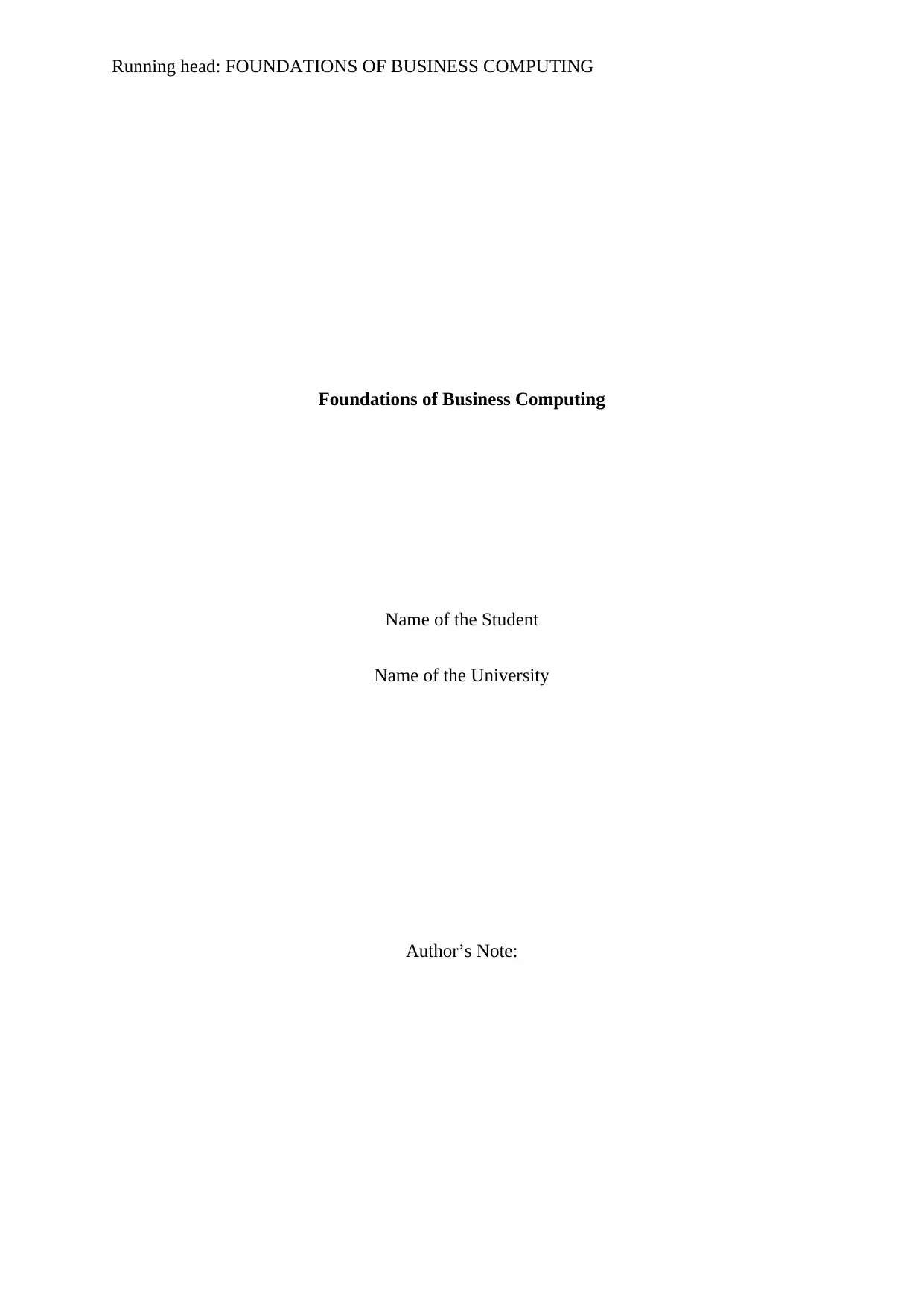
Running head: FOUNDATIONS OF BUSINESS COMPUTING
Foundations of Business Computing
Name of the Student
Name of the University
Author’s Note:
Foundations of Business Computing
Name of the Student
Name of the University
Author’s Note:
Secure Best Marks with AI Grader
Need help grading? Try our AI Grader for instant feedback on your assignments.
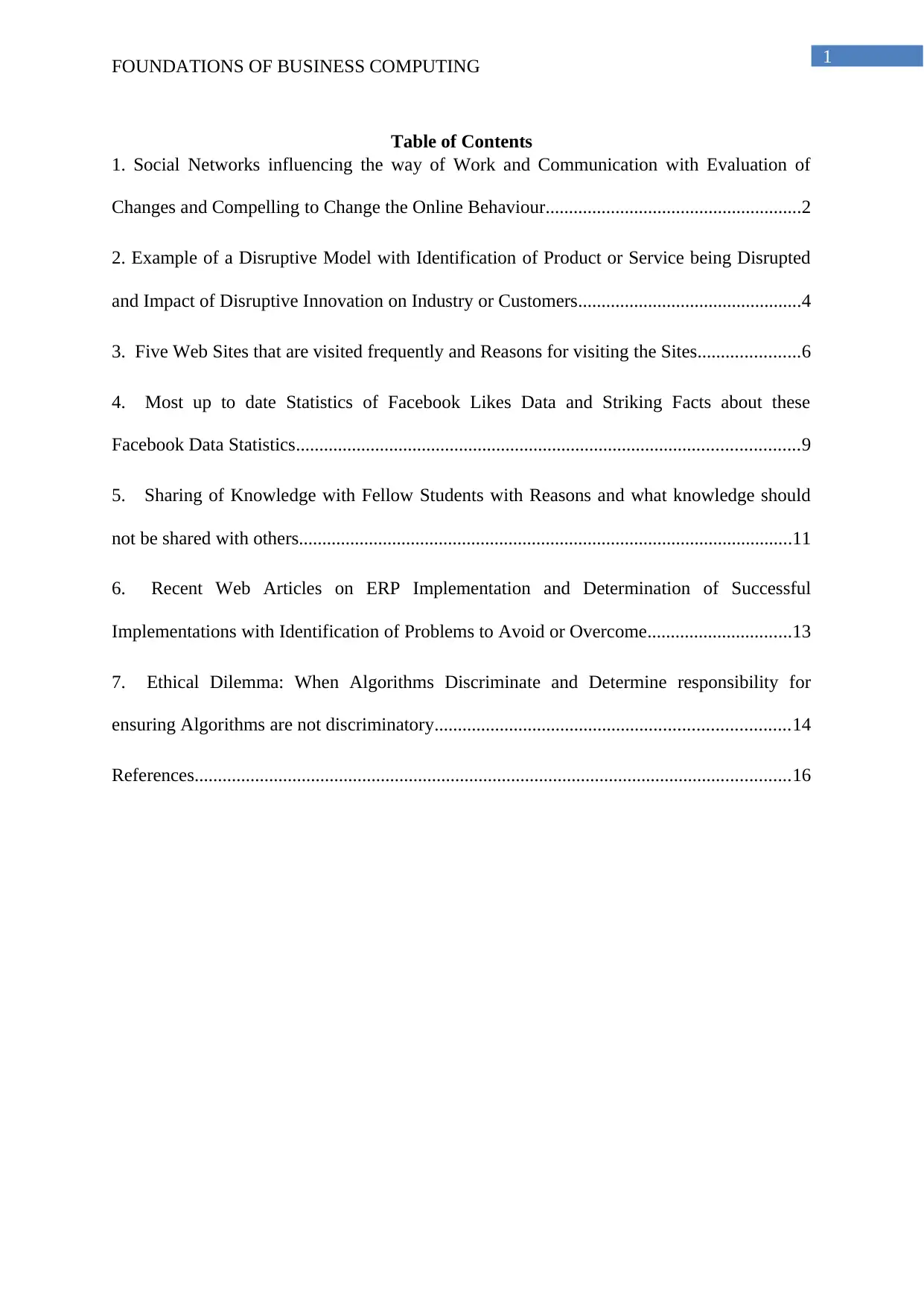
1
FOUNDATIONS OF BUSINESS COMPUTING
Table of Contents
1. Social Networks influencing the way of Work and Communication with Evaluation of
Changes and Compelling to Change the Online Behaviour.......................................................2
2. Example of a Disruptive Model with Identification of Product or Service being Disrupted
and Impact of Disruptive Innovation on Industry or Customers................................................4
3. Five Web Sites that are visited frequently and Reasons for visiting the Sites......................6
4. Most up to date Statistics of Facebook Likes Data and Striking Facts about these
Facebook Data Statistics............................................................................................................9
5. Sharing of Knowledge with Fellow Students with Reasons and what knowledge should
not be shared with others..........................................................................................................11
6. Recent Web Articles on ERP Implementation and Determination of Successful
Implementations with Identification of Problems to Avoid or Overcome...............................13
7. Ethical Dilemma: When Algorithms Discriminate and Determine responsibility for
ensuring Algorithms are not discriminatory............................................................................14
References................................................................................................................................16
FOUNDATIONS OF BUSINESS COMPUTING
Table of Contents
1. Social Networks influencing the way of Work and Communication with Evaluation of
Changes and Compelling to Change the Online Behaviour.......................................................2
2. Example of a Disruptive Model with Identification of Product or Service being Disrupted
and Impact of Disruptive Innovation on Industry or Customers................................................4
3. Five Web Sites that are visited frequently and Reasons for visiting the Sites......................6
4. Most up to date Statistics of Facebook Likes Data and Striking Facts about these
Facebook Data Statistics............................................................................................................9
5. Sharing of Knowledge with Fellow Students with Reasons and what knowledge should
not be shared with others..........................................................................................................11
6. Recent Web Articles on ERP Implementation and Determination of Successful
Implementations with Identification of Problems to Avoid or Overcome...............................13
7. Ethical Dilemma: When Algorithms Discriminate and Determine responsibility for
ensuring Algorithms are not discriminatory............................................................................14
References................................................................................................................................16
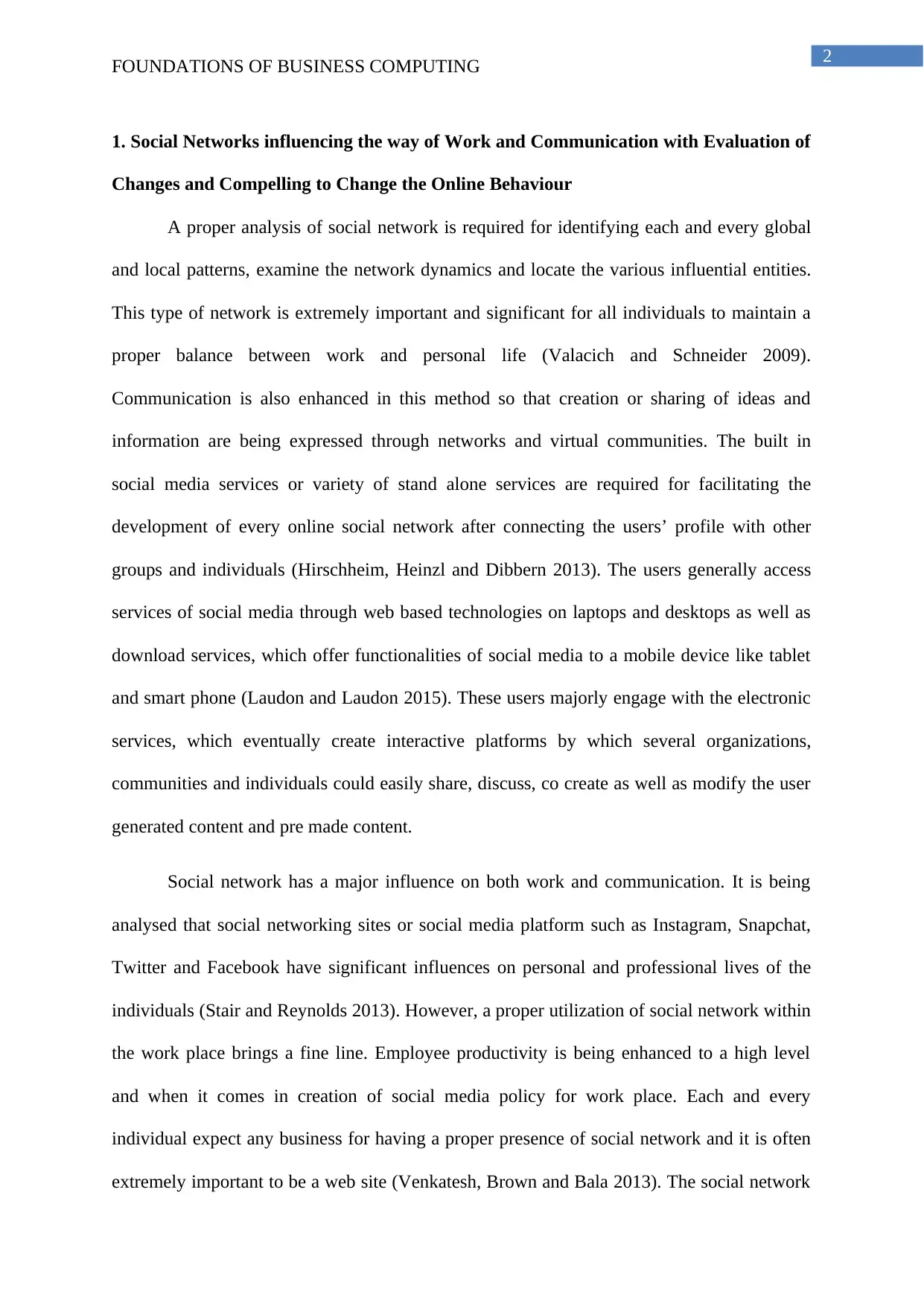
2
FOUNDATIONS OF BUSINESS COMPUTING
1. Social Networks influencing the way of Work and Communication with Evaluation of
Changes and Compelling to Change the Online Behaviour
A proper analysis of social network is required for identifying each and every global
and local patterns, examine the network dynamics and locate the various influential entities.
This type of network is extremely important and significant for all individuals to maintain a
proper balance between work and personal life (Valacich and Schneider 2009).
Communication is also enhanced in this method so that creation or sharing of ideas and
information are being expressed through networks and virtual communities. The built in
social media services or variety of stand alone services are required for facilitating the
development of every online social network after connecting the users’ profile with other
groups and individuals (Hirschheim, Heinzl and Dibbern 2013). The users generally access
services of social media through web based technologies on laptops and desktops as well as
download services, which offer functionalities of social media to a mobile device like tablet
and smart phone (Laudon and Laudon 2015). These users majorly engage with the electronic
services, which eventually create interactive platforms by which several organizations,
communities and individuals could easily share, discuss, co create as well as modify the user
generated content and pre made content.
Social network has a major influence on both work and communication. It is being
analysed that social networking sites or social media platform such as Instagram, Snapchat,
Twitter and Facebook have significant influences on personal and professional lives of the
individuals (Stair and Reynolds 2013). However, a proper utilization of social network within
the work place brings a fine line. Employee productivity is being enhanced to a high level
and when it comes in creation of social media policy for work place. Each and every
individual expect any business for having a proper presence of social network and it is often
extremely important to be a web site (Venkatesh, Brown and Bala 2013). The social network
FOUNDATIONS OF BUSINESS COMPUTING
1. Social Networks influencing the way of Work and Communication with Evaluation of
Changes and Compelling to Change the Online Behaviour
A proper analysis of social network is required for identifying each and every global
and local patterns, examine the network dynamics and locate the various influential entities.
This type of network is extremely important and significant for all individuals to maintain a
proper balance between work and personal life (Valacich and Schneider 2009).
Communication is also enhanced in this method so that creation or sharing of ideas and
information are being expressed through networks and virtual communities. The built in
social media services or variety of stand alone services are required for facilitating the
development of every online social network after connecting the users’ profile with other
groups and individuals (Hirschheim, Heinzl and Dibbern 2013). The users generally access
services of social media through web based technologies on laptops and desktops as well as
download services, which offer functionalities of social media to a mobile device like tablet
and smart phone (Laudon and Laudon 2015). These users majorly engage with the electronic
services, which eventually create interactive platforms by which several organizations,
communities and individuals could easily share, discuss, co create as well as modify the user
generated content and pre made content.
Social network has a major influence on both work and communication. It is being
analysed that social networking sites or social media platform such as Instagram, Snapchat,
Twitter and Facebook have significant influences on personal and professional lives of the
individuals (Stair and Reynolds 2013). However, a proper utilization of social network within
the work place brings a fine line. Employee productivity is being enhanced to a high level
and when it comes in creation of social media policy for work place. Each and every
individual expect any business for having a proper presence of social network and it is often
extremely important to be a web site (Venkatesh, Brown and Bala 2013). The social network

3
FOUNDATIONS OF BUSINESS COMPUTING
of the organization eventually enables an organizational member for connecting with the
customers and hence enhancing the organizational brand, bringing attention to products both
nationally and locally.
There are several negative effects of using social network, which could easily and
promptly destroy the professional requirements. Individual job performances and satisfaction
levels are highly impacted by this network. Social network can pose a major risk to the
working productivity as this productivity could be lowered to a certain level. Although, it
enhances globalization, there is a major integration of economies on the organization (Rainer
et al. 2013). Moreover, there are few societal issues as well that demonstrate about digital
world and how this entire digital world is affected by rapid development of
telecommunication and transportation technologies. As a result, communication is also
affected for that specific individual.
The emergence of social network has majorly created a new segment to facilitate
regular requirements of information and communication. Since technology is growing and
expanding to the highest range of communication, this social network has eventually become
the most vital technology for regular social interactions (Pearlson, Saunders and Galletta
2016). It even creates several opportunities for individuals so that they could easily and
promptly interact with one another in such a manner, which is both important and required
for motivating people.
The overall changes have been positive in respect to work and communication. The
major reason for this type of effect is that collection of online communication channels are
being dedicated to the community based inputs, interactions, better collaboration and content
sharing. In spite of the high costs, information systems and social networks have been
providing some of the most significant advantages to any specific individual (Galliers and
FOUNDATIONS OF BUSINESS COMPUTING
of the organization eventually enables an organizational member for connecting with the
customers and hence enhancing the organizational brand, bringing attention to products both
nationally and locally.
There are several negative effects of using social network, which could easily and
promptly destroy the professional requirements. Individual job performances and satisfaction
levels are highly impacted by this network. Social network can pose a major risk to the
working productivity as this productivity could be lowered to a certain level. Although, it
enhances globalization, there is a major integration of economies on the organization (Rainer
et al. 2013). Moreover, there are few societal issues as well that demonstrate about digital
world and how this entire digital world is affected by rapid development of
telecommunication and transportation technologies. As a result, communication is also
affected for that specific individual.
The emergence of social network has majorly created a new segment to facilitate
regular requirements of information and communication. Since technology is growing and
expanding to the highest range of communication, this social network has eventually become
the most vital technology for regular social interactions (Pearlson, Saunders and Galletta
2016). It even creates several opportunities for individuals so that they could easily and
promptly interact with one another in such a manner, which is both important and required
for motivating people.
The overall changes have been positive in respect to work and communication. The
major reason for this type of effect is that collection of online communication channels are
being dedicated to the community based inputs, interactions, better collaboration and content
sharing. In spite of the high costs, information systems and social networks have been
providing some of the most significant advantages to any specific individual (Galliers and
Secure Best Marks with AI Grader
Need help grading? Try our AI Grader for instant feedback on your assignments.
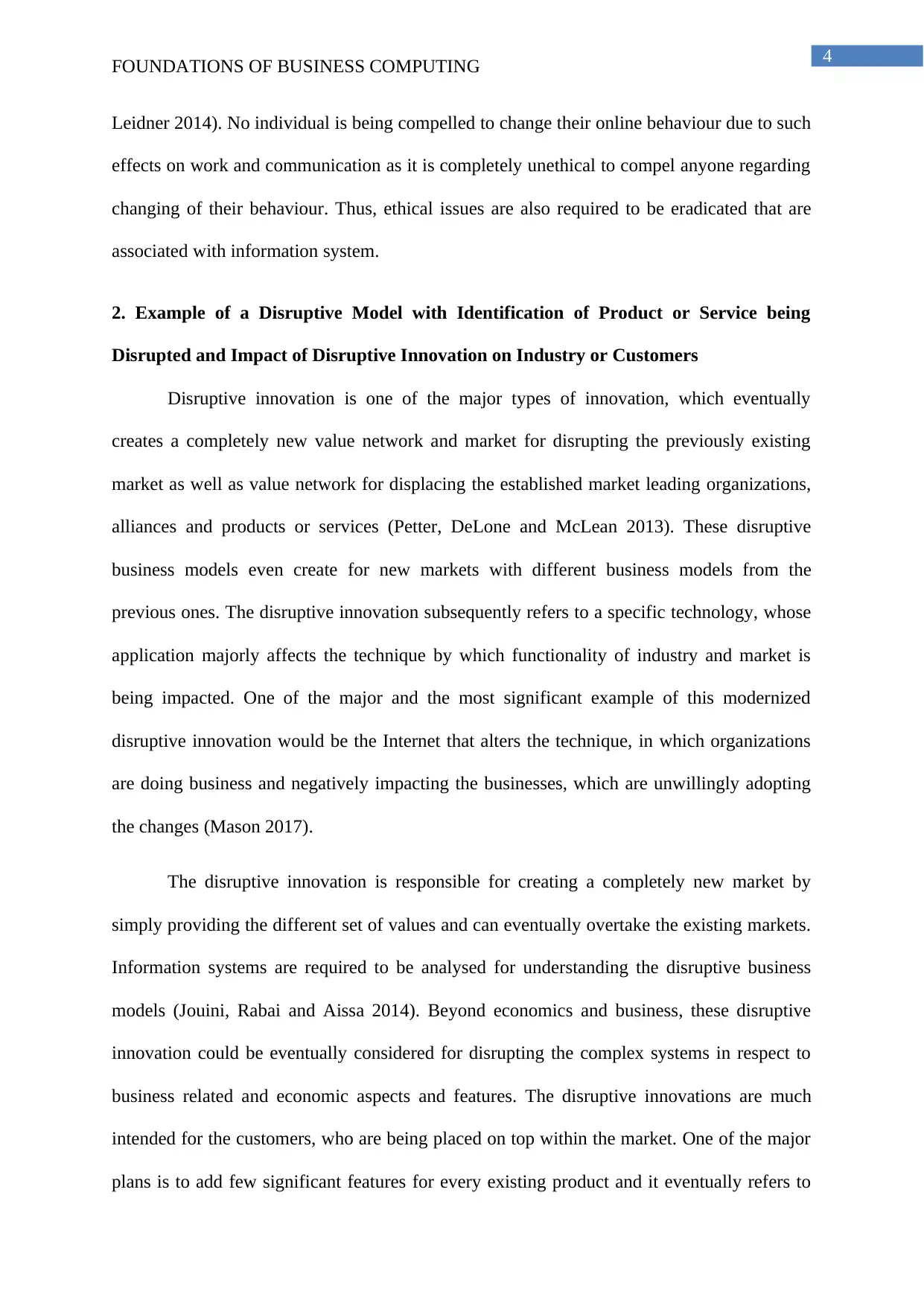
4
FOUNDATIONS OF BUSINESS COMPUTING
Leidner 2014). No individual is being compelled to change their online behaviour due to such
effects on work and communication as it is completely unethical to compel anyone regarding
changing of their behaviour. Thus, ethical issues are also required to be eradicated that are
associated with information system.
2. Example of a Disruptive Model with Identification of Product or Service being
Disrupted and Impact of Disruptive Innovation on Industry or Customers
Disruptive innovation is one of the major types of innovation, which eventually
creates a completely new value network and market for disrupting the previously existing
market as well as value network for displacing the established market leading organizations,
alliances and products or services (Petter, DeLone and McLean 2013). These disruptive
business models even create for new markets with different business models from the
previous ones. The disruptive innovation subsequently refers to a specific technology, whose
application majorly affects the technique by which functionality of industry and market is
being impacted. One of the major and the most significant example of this modernized
disruptive innovation would be the Internet that alters the technique, in which organizations
are doing business and negatively impacting the businesses, which are unwillingly adopting
the changes (Mason 2017).
The disruptive innovation is responsible for creating a completely new market by
simply providing the different set of values and can eventually overtake the existing markets.
Information systems are required to be analysed for understanding the disruptive business
models (Jouini, Rabai and Aissa 2014). Beyond economics and business, these disruptive
innovation could be eventually considered for disrupting the complex systems in respect to
business related and economic aspects and features. The disruptive innovations are much
intended for the customers, who are being placed on top within the market. One of the major
plans is to add few significant features for every existing product and it eventually refers to
FOUNDATIONS OF BUSINESS COMPUTING
Leidner 2014). No individual is being compelled to change their online behaviour due to such
effects on work and communication as it is completely unethical to compel anyone regarding
changing of their behaviour. Thus, ethical issues are also required to be eradicated that are
associated with information system.
2. Example of a Disruptive Model with Identification of Product or Service being
Disrupted and Impact of Disruptive Innovation on Industry or Customers
Disruptive innovation is one of the major types of innovation, which eventually
creates a completely new value network and market for disrupting the previously existing
market as well as value network for displacing the established market leading organizations,
alliances and products or services (Petter, DeLone and McLean 2013). These disruptive
business models even create for new markets with different business models from the
previous ones. The disruptive innovation subsequently refers to a specific technology, whose
application majorly affects the technique by which functionality of industry and market is
being impacted. One of the major and the most significant example of this modernized
disruptive innovation would be the Internet that alters the technique, in which organizations
are doing business and negatively impacting the businesses, which are unwillingly adopting
the changes (Mason 2017).
The disruptive innovation is responsible for creating a completely new market by
simply providing the different set of values and can eventually overtake the existing markets.
Information systems are required to be analysed for understanding the disruptive business
models (Jouini, Rabai and Aissa 2014). Beyond economics and business, these disruptive
innovation could be eventually considered for disrupting the complex systems in respect to
business related and economic aspects and features. The disruptive innovations are much
intended for the customers, who are being placed on top within the market. One of the major
plans is to add few significant features for every existing product and it eventually refers to
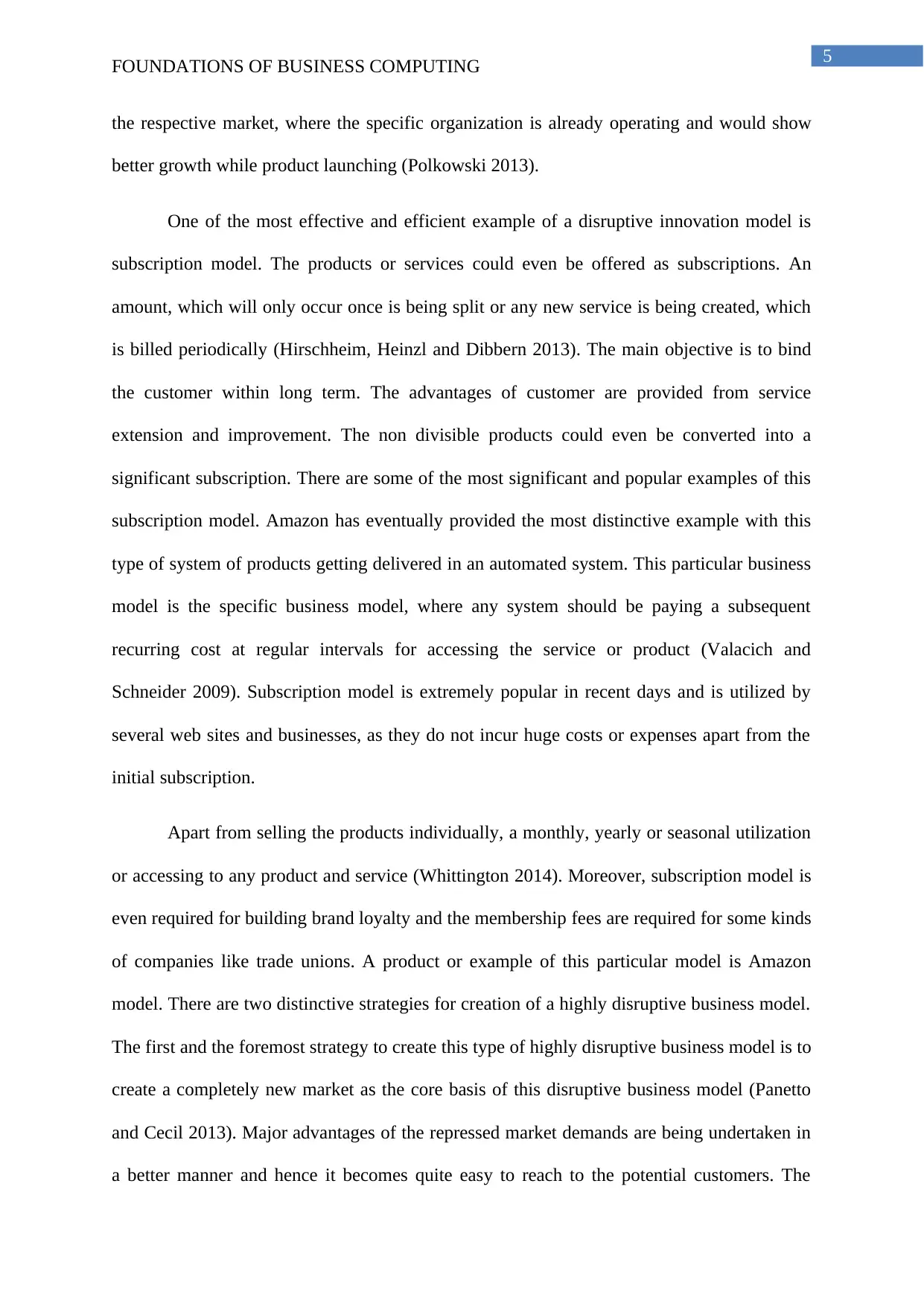
5
FOUNDATIONS OF BUSINESS COMPUTING
the respective market, where the specific organization is already operating and would show
better growth while product launching (Polkowski 2013).
One of the most effective and efficient example of a disruptive innovation model is
subscription model. The products or services could even be offered as subscriptions. An
amount, which will only occur once is being split or any new service is being created, which
is billed periodically (Hirschheim, Heinzl and Dibbern 2013). The main objective is to bind
the customer within long term. The advantages of customer are provided from service
extension and improvement. The non divisible products could even be converted into a
significant subscription. There are some of the most significant and popular examples of this
subscription model. Amazon has eventually provided the most distinctive example with this
type of system of products getting delivered in an automated system. This particular business
model is the specific business model, where any system should be paying a subsequent
recurring cost at regular intervals for accessing the service or product (Valacich and
Schneider 2009). Subscription model is extremely popular in recent days and is utilized by
several web sites and businesses, as they do not incur huge costs or expenses apart from the
initial subscription.
Apart from selling the products individually, a monthly, yearly or seasonal utilization
or accessing to any product and service (Whittington 2014). Moreover, subscription model is
even required for building brand loyalty and the membership fees are required for some kinds
of companies like trade unions. A product or example of this particular model is Amazon
model. There are two distinctive strategies for creation of a highly disruptive business model.
The first and the foremost strategy to create this type of highly disruptive business model is to
create a completely new market as the core basis of this disruptive business model (Panetto
and Cecil 2013). Major advantages of the repressed market demands are being undertaken in
a better manner and hence it becomes quite easy to reach to the potential customers. The
FOUNDATIONS OF BUSINESS COMPUTING
the respective market, where the specific organization is already operating and would show
better growth while product launching (Polkowski 2013).
One of the most effective and efficient example of a disruptive innovation model is
subscription model. The products or services could even be offered as subscriptions. An
amount, which will only occur once is being split or any new service is being created, which
is billed periodically (Hirschheim, Heinzl and Dibbern 2013). The main objective is to bind
the customer within long term. The advantages of customer are provided from service
extension and improvement. The non divisible products could even be converted into a
significant subscription. There are some of the most significant and popular examples of this
subscription model. Amazon has eventually provided the most distinctive example with this
type of system of products getting delivered in an automated system. This particular business
model is the specific business model, where any system should be paying a subsequent
recurring cost at regular intervals for accessing the service or product (Valacich and
Schneider 2009). Subscription model is extremely popular in recent days and is utilized by
several web sites and businesses, as they do not incur huge costs or expenses apart from the
initial subscription.
Apart from selling the products individually, a monthly, yearly or seasonal utilization
or accessing to any product and service (Whittington 2014). Moreover, subscription model is
even required for building brand loyalty and the membership fees are required for some kinds
of companies like trade unions. A product or example of this particular model is Amazon
model. There are two distinctive strategies for creation of a highly disruptive business model.
The first and the foremost strategy to create this type of highly disruptive business model is to
create a completely new market as the core basis of this disruptive business model (Panetto
and Cecil 2013). Major advantages of the repressed market demands are being undertaken in
a better manner and hence it becomes quite easy to reach to the potential customers. The
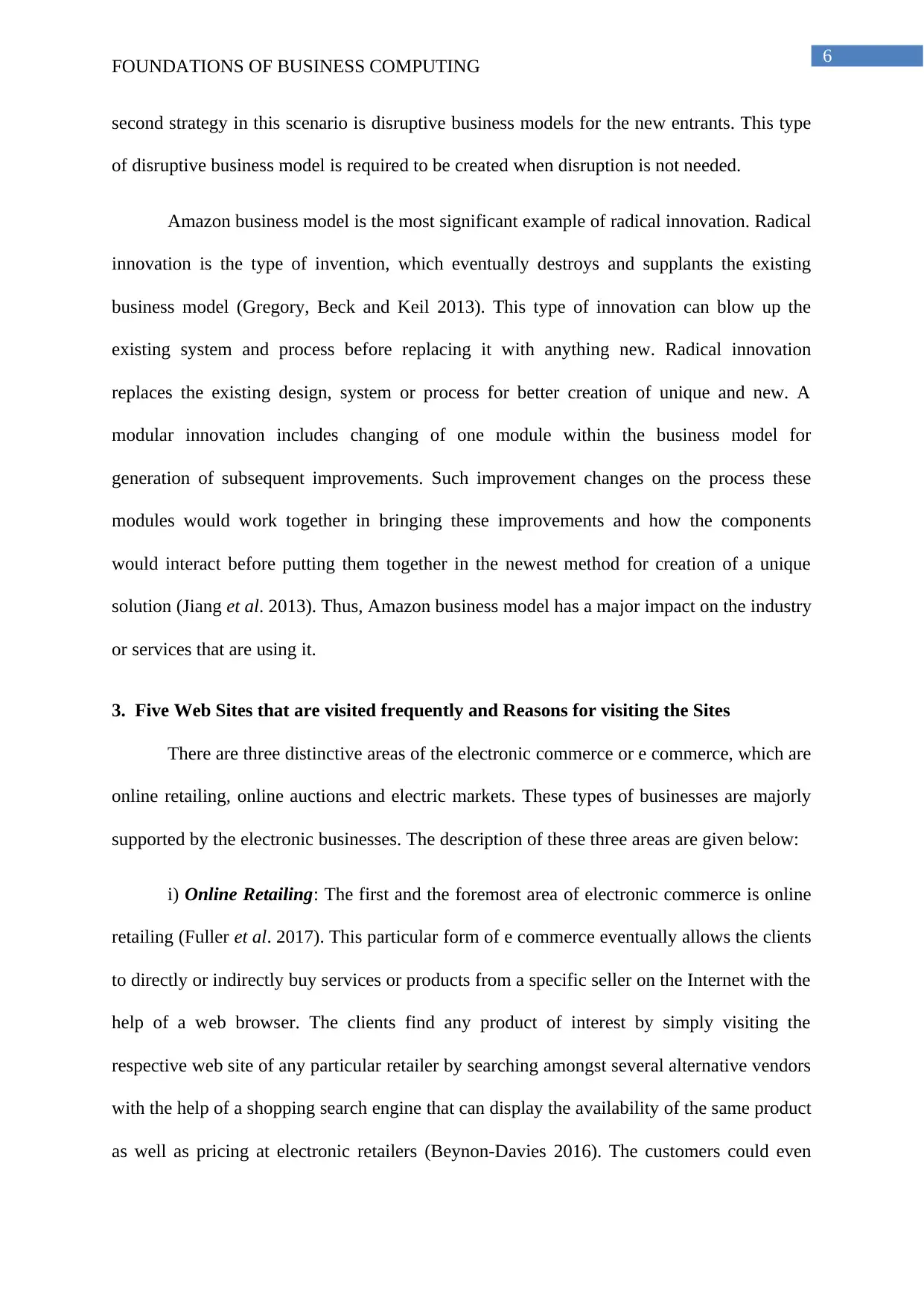
6
FOUNDATIONS OF BUSINESS COMPUTING
second strategy in this scenario is disruptive business models for the new entrants. This type
of disruptive business model is required to be created when disruption is not needed.
Amazon business model is the most significant example of radical innovation. Radical
innovation is the type of invention, which eventually destroys and supplants the existing
business model (Gregory, Beck and Keil 2013). This type of innovation can blow up the
existing system and process before replacing it with anything new. Radical innovation
replaces the existing design, system or process for better creation of unique and new. A
modular innovation includes changing of one module within the business model for
generation of subsequent improvements. Such improvement changes on the process these
modules would work together in bringing these improvements and how the components
would interact before putting them together in the newest method for creation of a unique
solution (Jiang et al. 2013). Thus, Amazon business model has a major impact on the industry
or services that are using it.
3. Five Web Sites that are visited frequently and Reasons for visiting the Sites
There are three distinctive areas of the electronic commerce or e commerce, which are
online retailing, online auctions and electric markets. These types of businesses are majorly
supported by the electronic businesses. The description of these three areas are given below:
i) Online Retailing: The first and the foremost area of electronic commerce is online
retailing (Fuller et al. 2017). This particular form of e commerce eventually allows the clients
to directly or indirectly buy services or products from a specific seller on the Internet with the
help of a web browser. The clients find any product of interest by simply visiting the
respective web site of any particular retailer by searching amongst several alternative vendors
with the help of a shopping search engine that can display the availability of the same product
as well as pricing at electronic retailers (Beynon-Davies 2016). The customers could even
FOUNDATIONS OF BUSINESS COMPUTING
second strategy in this scenario is disruptive business models for the new entrants. This type
of disruptive business model is required to be created when disruption is not needed.
Amazon business model is the most significant example of radical innovation. Radical
innovation is the type of invention, which eventually destroys and supplants the existing
business model (Gregory, Beck and Keil 2013). This type of innovation can blow up the
existing system and process before replacing it with anything new. Radical innovation
replaces the existing design, system or process for better creation of unique and new. A
modular innovation includes changing of one module within the business model for
generation of subsequent improvements. Such improvement changes on the process these
modules would work together in bringing these improvements and how the components
would interact before putting them together in the newest method for creation of a unique
solution (Jiang et al. 2013). Thus, Amazon business model has a major impact on the industry
or services that are using it.
3. Five Web Sites that are visited frequently and Reasons for visiting the Sites
There are three distinctive areas of the electronic commerce or e commerce, which are
online retailing, online auctions and electric markets. These types of businesses are majorly
supported by the electronic businesses. The description of these three areas are given below:
i) Online Retailing: The first and the foremost area of electronic commerce is online
retailing (Fuller et al. 2017). This particular form of e commerce eventually allows the clients
to directly or indirectly buy services or products from a specific seller on the Internet with the
help of a web browser. The clients find any product of interest by simply visiting the
respective web site of any particular retailer by searching amongst several alternative vendors
with the help of a shopping search engine that can display the availability of the same product
as well as pricing at electronic retailers (Beynon-Davies 2016). The customers could even
Paraphrase This Document
Need a fresh take? Get an instant paraphrase of this document with our AI Paraphraser
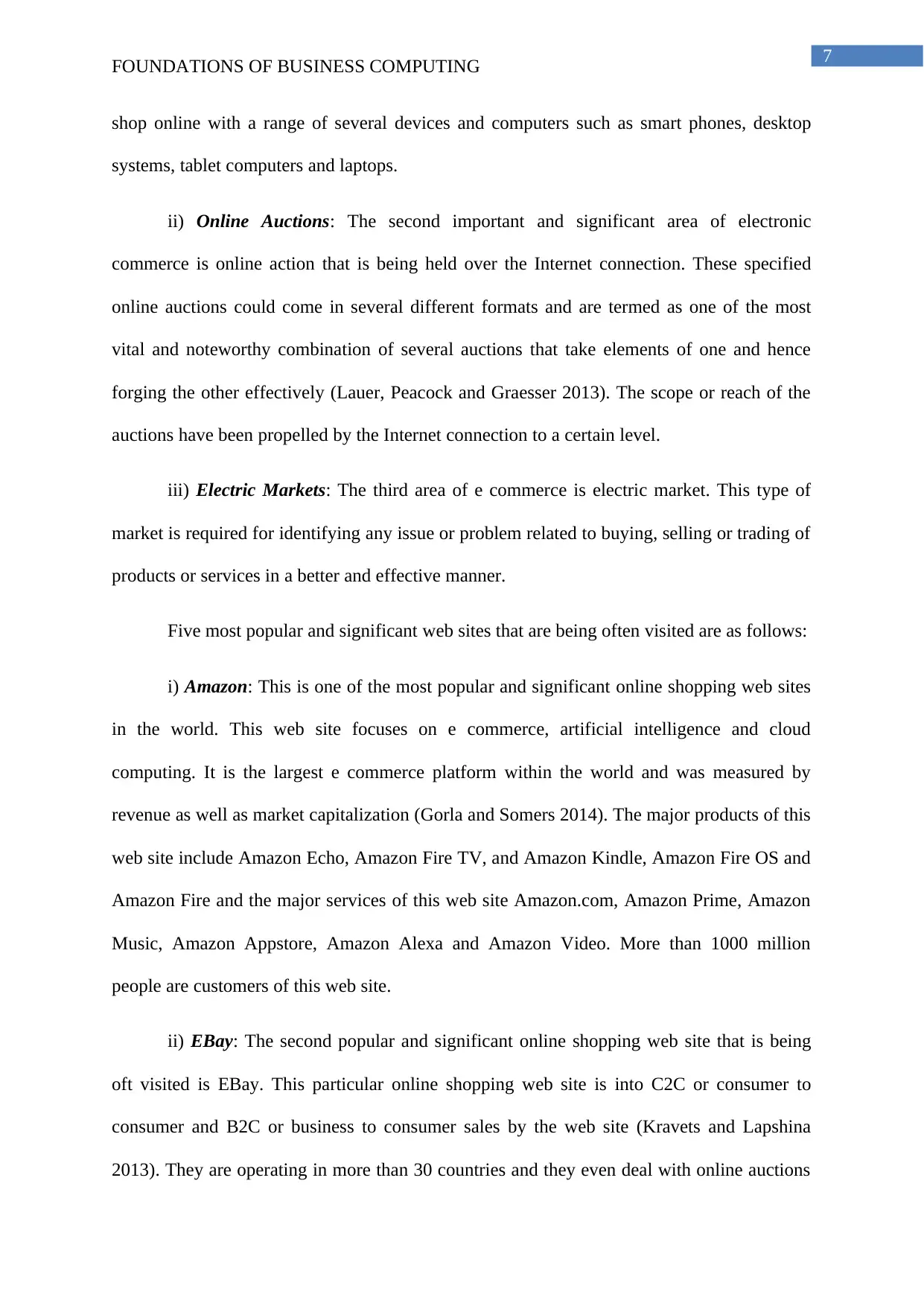
7
FOUNDATIONS OF BUSINESS COMPUTING
shop online with a range of several devices and computers such as smart phones, desktop
systems, tablet computers and laptops.
ii) Online Auctions: The second important and significant area of electronic
commerce is online action that is being held over the Internet connection. These specified
online auctions could come in several different formats and are termed as one of the most
vital and noteworthy combination of several auctions that take elements of one and hence
forging the other effectively (Lauer, Peacock and Graesser 2013). The scope or reach of the
auctions have been propelled by the Internet connection to a certain level.
iii) Electric Markets: The third area of e commerce is electric market. This type of
market is required for identifying any issue or problem related to buying, selling or trading of
products or services in a better and effective manner.
Five most popular and significant web sites that are being often visited are as follows:
i) Amazon: This is one of the most popular and significant online shopping web sites
in the world. This web site focuses on e commerce, artificial intelligence and cloud
computing. It is the largest e commerce platform within the world and was measured by
revenue as well as market capitalization (Gorla and Somers 2014). The major products of this
web site include Amazon Echo, Amazon Fire TV, and Amazon Kindle, Amazon Fire OS and
Amazon Fire and the major services of this web site Amazon.com, Amazon Prime, Amazon
Music, Amazon Appstore, Amazon Alexa and Amazon Video. More than 1000 million
people are customers of this web site.
ii) EBay: The second popular and significant online shopping web site that is being
oft visited is EBay. This particular online shopping web site is into C2C or consumer to
consumer and B2C or business to consumer sales by the web site (Kravets and Lapshina
2013). They are operating in more than 30 countries and they even deal with online auctions
FOUNDATIONS OF BUSINESS COMPUTING
shop online with a range of several devices and computers such as smart phones, desktop
systems, tablet computers and laptops.
ii) Online Auctions: The second important and significant area of electronic
commerce is online action that is being held over the Internet connection. These specified
online auctions could come in several different formats and are termed as one of the most
vital and noteworthy combination of several auctions that take elements of one and hence
forging the other effectively (Lauer, Peacock and Graesser 2013). The scope or reach of the
auctions have been propelled by the Internet connection to a certain level.
iii) Electric Markets: The third area of e commerce is electric market. This type of
market is required for identifying any issue or problem related to buying, selling or trading of
products or services in a better and effective manner.
Five most popular and significant web sites that are being often visited are as follows:
i) Amazon: This is one of the most popular and significant online shopping web sites
in the world. This web site focuses on e commerce, artificial intelligence and cloud
computing. It is the largest e commerce platform within the world and was measured by
revenue as well as market capitalization (Gorla and Somers 2014). The major products of this
web site include Amazon Echo, Amazon Fire TV, and Amazon Kindle, Amazon Fire OS and
Amazon Fire and the major services of this web site Amazon.com, Amazon Prime, Amazon
Music, Amazon Appstore, Amazon Alexa and Amazon Video. More than 1000 million
people are customers of this web site.
ii) EBay: The second popular and significant online shopping web site that is being
oft visited is EBay. This particular online shopping web site is into C2C or consumer to
consumer and B2C or business to consumer sales by the web site (Kravets and Lapshina
2013). They are operating in more than 30 countries and they even deal with online auctions
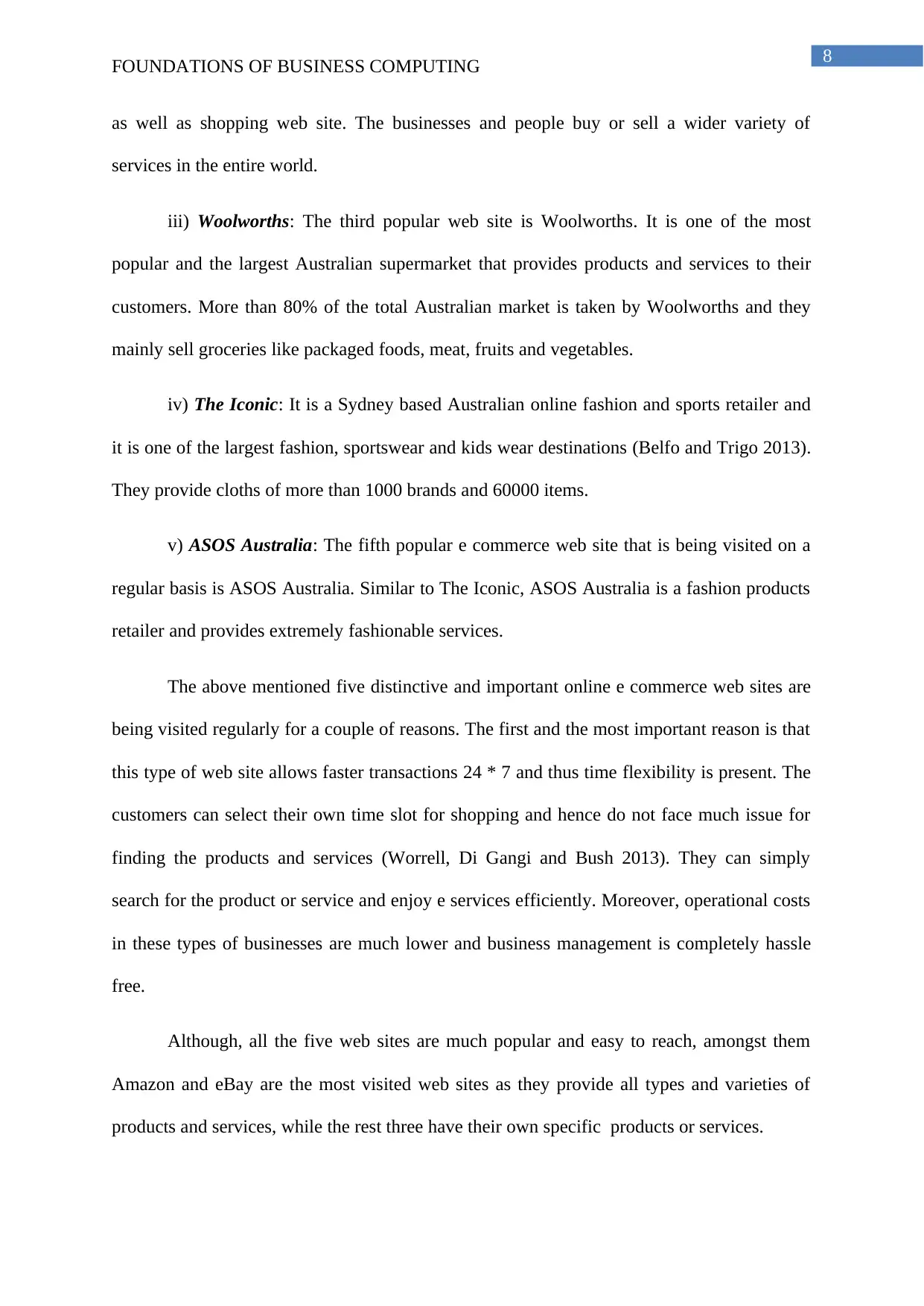
8
FOUNDATIONS OF BUSINESS COMPUTING
as well as shopping web site. The businesses and people buy or sell a wider variety of
services in the entire world.
iii) Woolworths: The third popular web site is Woolworths. It is one of the most
popular and the largest Australian supermarket that provides products and services to their
customers. More than 80% of the total Australian market is taken by Woolworths and they
mainly sell groceries like packaged foods, meat, fruits and vegetables.
iv) The Iconic: It is a Sydney based Australian online fashion and sports retailer and
it is one of the largest fashion, sportswear and kids wear destinations (Belfo and Trigo 2013).
They provide cloths of more than 1000 brands and 60000 items.
v) ASOS Australia: The fifth popular e commerce web site that is being visited on a
regular basis is ASOS Australia. Similar to The Iconic, ASOS Australia is a fashion products
retailer and provides extremely fashionable services.
The above mentioned five distinctive and important online e commerce web sites are
being visited regularly for a couple of reasons. The first and the most important reason is that
this type of web site allows faster transactions 24 * 7 and thus time flexibility is present. The
customers can select their own time slot for shopping and hence do not face much issue for
finding the products and services (Worrell, Di Gangi and Bush 2013). They can simply
search for the product or service and enjoy e services efficiently. Moreover, operational costs
in these types of businesses are much lower and business management is completely hassle
free.
Although, all the five web sites are much popular and easy to reach, amongst them
Amazon and eBay are the most visited web sites as they provide all types and varieties of
products and services, while the rest three have their own specific products or services.
FOUNDATIONS OF BUSINESS COMPUTING
as well as shopping web site. The businesses and people buy or sell a wider variety of
services in the entire world.
iii) Woolworths: The third popular web site is Woolworths. It is one of the most
popular and the largest Australian supermarket that provides products and services to their
customers. More than 80% of the total Australian market is taken by Woolworths and they
mainly sell groceries like packaged foods, meat, fruits and vegetables.
iv) The Iconic: It is a Sydney based Australian online fashion and sports retailer and
it is one of the largest fashion, sportswear and kids wear destinations (Belfo and Trigo 2013).
They provide cloths of more than 1000 brands and 60000 items.
v) ASOS Australia: The fifth popular e commerce web site that is being visited on a
regular basis is ASOS Australia. Similar to The Iconic, ASOS Australia is a fashion products
retailer and provides extremely fashionable services.
The above mentioned five distinctive and important online e commerce web sites are
being visited regularly for a couple of reasons. The first and the most important reason is that
this type of web site allows faster transactions 24 * 7 and thus time flexibility is present. The
customers can select their own time slot for shopping and hence do not face much issue for
finding the products and services (Worrell, Di Gangi and Bush 2013). They can simply
search for the product or service and enjoy e services efficiently. Moreover, operational costs
in these types of businesses are much lower and business management is completely hassle
free.
Although, all the five web sites are much popular and easy to reach, amongst them
Amazon and eBay are the most visited web sites as they provide all types and varieties of
products and services, while the rest three have their own specific products or services.
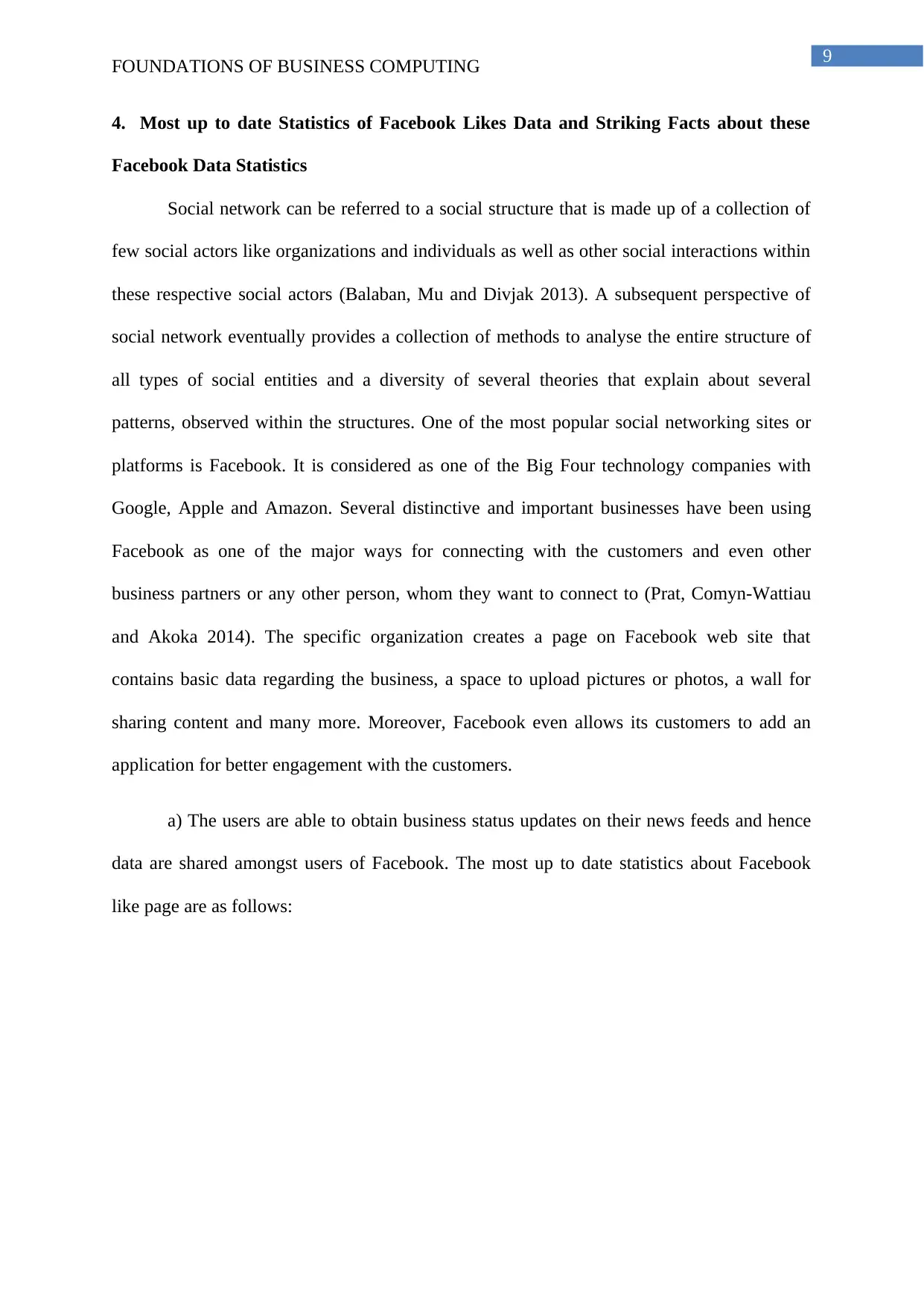
9
FOUNDATIONS OF BUSINESS COMPUTING
4. Most up to date Statistics of Facebook Likes Data and Striking Facts about these
Facebook Data Statistics
Social network can be referred to a social structure that is made up of a collection of
few social actors like organizations and individuals as well as other social interactions within
these respective social actors (Balaban, Mu and Divjak 2013). A subsequent perspective of
social network eventually provides a collection of methods to analyse the entire structure of
all types of social entities and a diversity of several theories that explain about several
patterns, observed within the structures. One of the most popular social networking sites or
platforms is Facebook. It is considered as one of the Big Four technology companies with
Google, Apple and Amazon. Several distinctive and important businesses have been using
Facebook as one of the major ways for connecting with the customers and even other
business partners or any other person, whom they want to connect to (Prat, Comyn-Wattiau
and Akoka 2014). The specific organization creates a page on Facebook web site that
contains basic data regarding the business, a space to upload pictures or photos, a wall for
sharing content and many more. Moreover, Facebook even allows its customers to add an
application for better engagement with the customers.
a) The users are able to obtain business status updates on their news feeds and hence
data are shared amongst users of Facebook. The most up to date statistics about Facebook
like page are as follows:
FOUNDATIONS OF BUSINESS COMPUTING
4. Most up to date Statistics of Facebook Likes Data and Striking Facts about these
Facebook Data Statistics
Social network can be referred to a social structure that is made up of a collection of
few social actors like organizations and individuals as well as other social interactions within
these respective social actors (Balaban, Mu and Divjak 2013). A subsequent perspective of
social network eventually provides a collection of methods to analyse the entire structure of
all types of social entities and a diversity of several theories that explain about several
patterns, observed within the structures. One of the most popular social networking sites or
platforms is Facebook. It is considered as one of the Big Four technology companies with
Google, Apple and Amazon. Several distinctive and important businesses have been using
Facebook as one of the major ways for connecting with the customers and even other
business partners or any other person, whom they want to connect to (Prat, Comyn-Wattiau
and Akoka 2014). The specific organization creates a page on Facebook web site that
contains basic data regarding the business, a space to upload pictures or photos, a wall for
sharing content and many more. Moreover, Facebook even allows its customers to add an
application for better engagement with the customers.
a) The users are able to obtain business status updates on their news feeds and hence
data are shared amongst users of Facebook. The most up to date statistics about Facebook
like page are as follows:
Secure Best Marks with AI Grader
Need help grading? Try our AI Grader for instant feedback on your assignments.

10
FOUNDATIONS OF BUSINESS COMPUTING
Figure 1: Most up to date Statistics of May 2019
(Source: Braglia and Frosolini 2014)
b) The most striking or important fact about these specific statistics can be referred to
as that Samsung has acquired the market and is extremely popular after Facebook. Moreover,
due to such improvement of position of Samsung, the other significant entities have lost their
respective positions (Paré et al., 2013). The Facebook advertising eventually influences
beyond social media and they are responsible for spreading the entire brand loyalty to several
popular and significant users in the entire world. With the popularity over Disney, Google
and Fox, Facebook has been ranked first and they are enjoying more advertising revenue.
c) Yes the numbers have changed since April 2016.
FOUNDATIONS OF BUSINESS COMPUTING
Figure 1: Most up to date Statistics of May 2019
(Source: Braglia and Frosolini 2014)
b) The most striking or important fact about these specific statistics can be referred to
as that Samsung has acquired the market and is extremely popular after Facebook. Moreover,
due to such improvement of position of Samsung, the other significant entities have lost their
respective positions (Paré et al., 2013). The Facebook advertising eventually influences
beyond social media and they are responsible for spreading the entire brand loyalty to several
popular and significant users in the entire world. With the popularity over Disney, Google
and Fox, Facebook has been ranked first and they are enjoying more advertising revenue.
c) Yes the numbers have changed since April 2016.
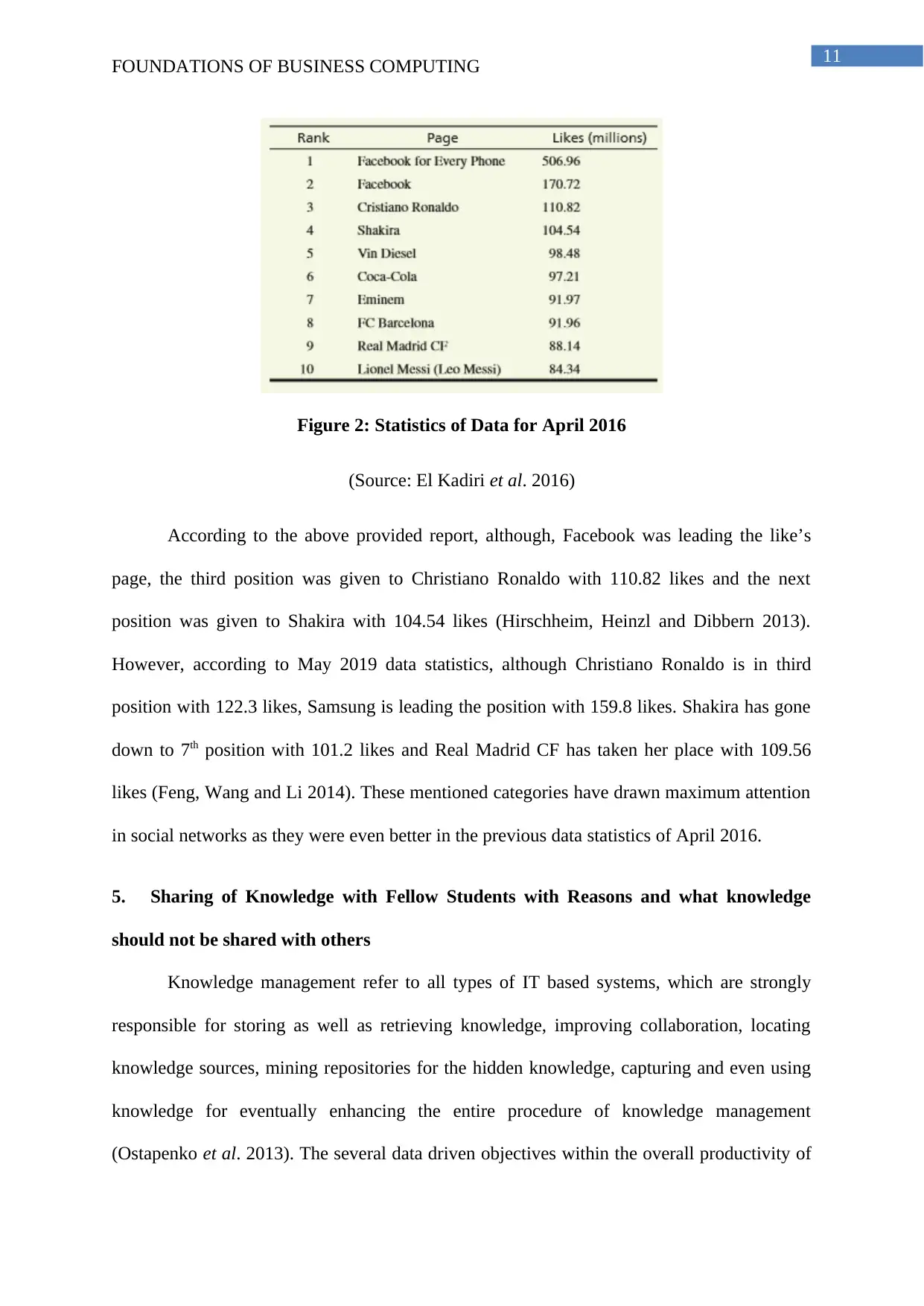
11
FOUNDATIONS OF BUSINESS COMPUTING
Figure 2: Statistics of Data for April 2016
(Source: El Kadiri et al. 2016)
According to the above provided report, although, Facebook was leading the like’s
page, the third position was given to Christiano Ronaldo with 110.82 likes and the next
position was given to Shakira with 104.54 likes (Hirschheim, Heinzl and Dibbern 2013).
However, according to May 2019 data statistics, although Christiano Ronaldo is in third
position with 122.3 likes, Samsung is leading the position with 159.8 likes. Shakira has gone
down to 7th position with 101.2 likes and Real Madrid CF has taken her place with 109.56
likes (Feng, Wang and Li 2014). These mentioned categories have drawn maximum attention
in social networks as they were even better in the previous data statistics of April 2016.
5. Sharing of Knowledge with Fellow Students with Reasons and what knowledge
should not be shared with others
Knowledge management refer to all types of IT based systems, which are strongly
responsible for storing as well as retrieving knowledge, improving collaboration, locating
knowledge sources, mining repositories for the hidden knowledge, capturing and even using
knowledge for eventually enhancing the entire procedure of knowledge management
(Ostapenko et al. 2013). The several data driven objectives within the overall productivity of
FOUNDATIONS OF BUSINESS COMPUTING
Figure 2: Statistics of Data for April 2016
(Source: El Kadiri et al. 2016)
According to the above provided report, although, Facebook was leading the like’s
page, the third position was given to Christiano Ronaldo with 110.82 likes and the next
position was given to Shakira with 104.54 likes (Hirschheim, Heinzl and Dibbern 2013).
However, according to May 2019 data statistics, although Christiano Ronaldo is in third
position with 122.3 likes, Samsung is leading the position with 159.8 likes. Shakira has gone
down to 7th position with 101.2 likes and Real Madrid CF has taken her place with 109.56
likes (Feng, Wang and Li 2014). These mentioned categories have drawn maximum attention
in social networks as they were even better in the previous data statistics of April 2016.
5. Sharing of Knowledge with Fellow Students with Reasons and what knowledge
should not be shared with others
Knowledge management refer to all types of IT based systems, which are strongly
responsible for storing as well as retrieving knowledge, improving collaboration, locating
knowledge sources, mining repositories for the hidden knowledge, capturing and even using
knowledge for eventually enhancing the entire procedure of knowledge management
(Ostapenko et al. 2013). The several data driven objectives within the overall productivity of

12
FOUNDATIONS OF BUSINESS COMPUTING
business, a proper competitive business model and few others are being involved within this
KMS. Better knowledge sharing is possible with the subsequent incorporation of knowledge
management system.
Few students have decided to launch a proper knowledge management system to
share the class notes as well as study tips (Force and Initiative 2013). Better business related
decisions are possible with the involvement of knowledge management system and hence this
particular news should be shared with all the fellow students so that they are able to
understand the importance of KMS. It could be applied after inclusion of both explicit and
implicit knowledge and the differentiation has eventually led towards classification of
business intelligence as the portion of great knowledge management, in which a wide
category can drive the decisions towards more fundamental method (Järveläinen 2013). As
knowledge management is the core procedure to create, share, utilize as well as manage the
confidential or sensitive information and knowledge of any specific business or student, it
could be termed as the most effective and efficient information system that helps in making
better decisions.
There are two types of knowledge for any student or college, which as implicit and
explicit knowledge. Implicit knowledge can be termed as the type of knowledge, which is
being obtained through certain incidental activities and even without awareness that learning
is being occurring (Valacich and Schneider 2009). The most prominent examples of this type
of implicit knowledge is to know about basic activities or actions like walking, running,
riding bicycle and even swimming. This type of knowledge is obtained from family and
friends and it cannot be shared through knowledge management system under any
circumstance. However, on the other hand, explicit knowledge can be termed as the
knowledge, which could be readily and easily articulated, accessed, stored and also codified
in an effective manner (Laudon and Laudon 2015). Maximum forms of this explicit
FOUNDATIONS OF BUSINESS COMPUTING
business, a proper competitive business model and few others are being involved within this
KMS. Better knowledge sharing is possible with the subsequent incorporation of knowledge
management system.
Few students have decided to launch a proper knowledge management system to
share the class notes as well as study tips (Force and Initiative 2013). Better business related
decisions are possible with the involvement of knowledge management system and hence this
particular news should be shared with all the fellow students so that they are able to
understand the importance of KMS. It could be applied after inclusion of both explicit and
implicit knowledge and the differentiation has eventually led towards classification of
business intelligence as the portion of great knowledge management, in which a wide
category can drive the decisions towards more fundamental method (Järveläinen 2013). As
knowledge management is the core procedure to create, share, utilize as well as manage the
confidential or sensitive information and knowledge of any specific business or student, it
could be termed as the most effective and efficient information system that helps in making
better decisions.
There are two types of knowledge for any student or college, which as implicit and
explicit knowledge. Implicit knowledge can be termed as the type of knowledge, which is
being obtained through certain incidental activities and even without awareness that learning
is being occurring (Valacich and Schneider 2009). The most prominent examples of this type
of implicit knowledge is to know about basic activities or actions like walking, running,
riding bicycle and even swimming. This type of knowledge is obtained from family and
friends and it cannot be shared through knowledge management system under any
circumstance. However, on the other hand, explicit knowledge can be termed as the
knowledge, which could be readily and easily articulated, accessed, stored and also codified
in an effective manner (Laudon and Laudon 2015). Maximum forms of this explicit
Paraphrase This Document
Need a fresh take? Get an instant paraphrase of this document with our AI Paraphraser
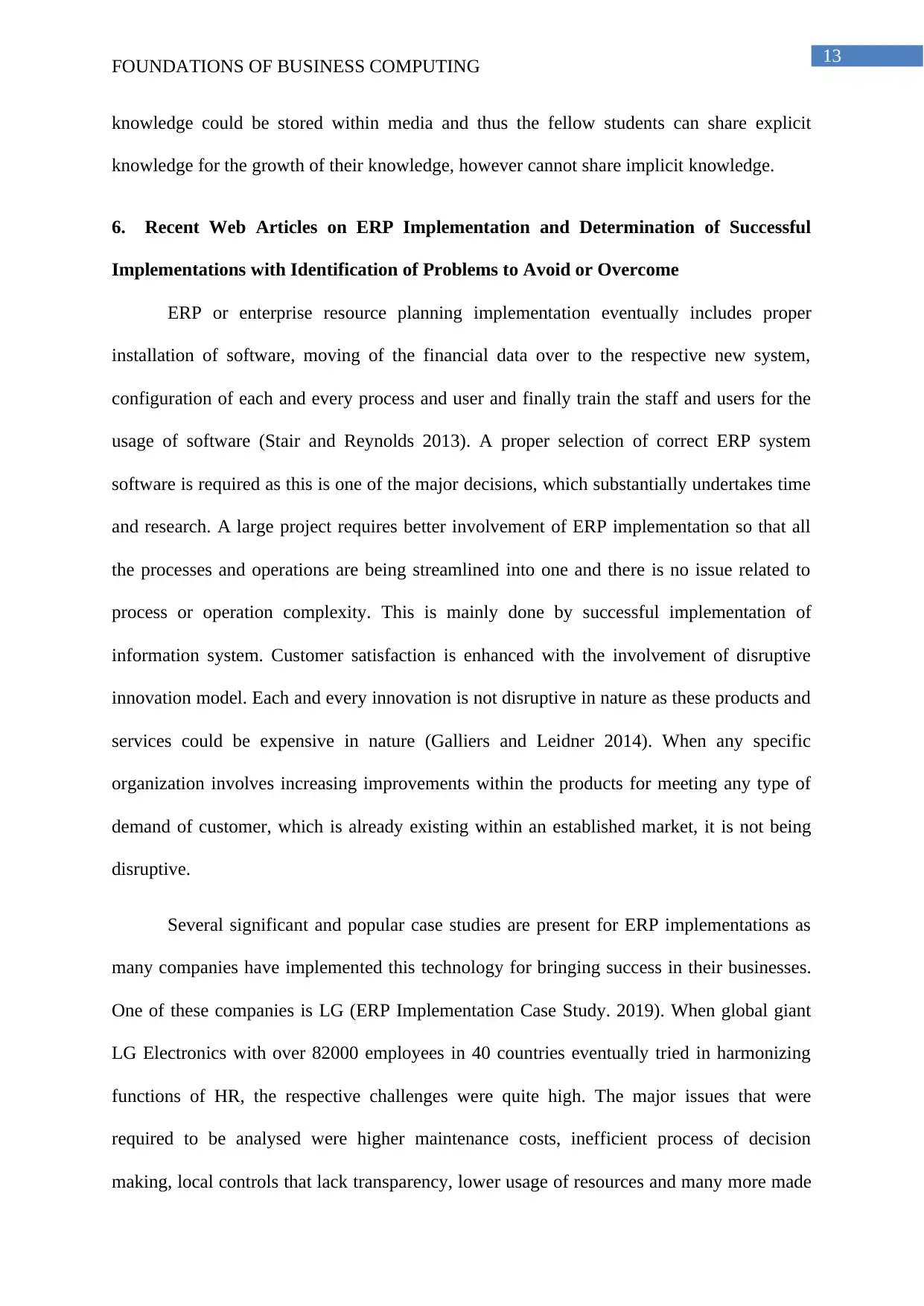
13
FOUNDATIONS OF BUSINESS COMPUTING
knowledge could be stored within media and thus the fellow students can share explicit
knowledge for the growth of their knowledge, however cannot share implicit knowledge.
6. Recent Web Articles on ERP Implementation and Determination of Successful
Implementations with Identification of Problems to Avoid or Overcome
ERP or enterprise resource planning implementation eventually includes proper
installation of software, moving of the financial data over to the respective new system,
configuration of each and every process and user and finally train the staff and users for the
usage of software (Stair and Reynolds 2013). A proper selection of correct ERP system
software is required as this is one of the major decisions, which substantially undertakes time
and research. A large project requires better involvement of ERP implementation so that all
the processes and operations are being streamlined into one and there is no issue related to
process or operation complexity. This is mainly done by successful implementation of
information system. Customer satisfaction is enhanced with the involvement of disruptive
innovation model. Each and every innovation is not disruptive in nature as these products and
services could be expensive in nature (Galliers and Leidner 2014). When any specific
organization involves increasing improvements within the products for meeting any type of
demand of customer, which is already existing within an established market, it is not being
disruptive.
Several significant and popular case studies are present for ERP implementations as
many companies have implemented this technology for bringing success in their businesses.
One of these companies is LG (ERP Implementation Case Study. 2019). When global giant
LG Electronics with over 82000 employees in 40 countries eventually tried in harmonizing
functions of HR, the respective challenges were quite high. The major issues that were
required to be analysed were higher maintenance costs, inefficient process of decision
making, local controls that lack transparency, lower usage of resources and many more made
FOUNDATIONS OF BUSINESS COMPUTING
knowledge could be stored within media and thus the fellow students can share explicit
knowledge for the growth of their knowledge, however cannot share implicit knowledge.
6. Recent Web Articles on ERP Implementation and Determination of Successful
Implementations with Identification of Problems to Avoid or Overcome
ERP or enterprise resource planning implementation eventually includes proper
installation of software, moving of the financial data over to the respective new system,
configuration of each and every process and user and finally train the staff and users for the
usage of software (Stair and Reynolds 2013). A proper selection of correct ERP system
software is required as this is one of the major decisions, which substantially undertakes time
and research. A large project requires better involvement of ERP implementation so that all
the processes and operations are being streamlined into one and there is no issue related to
process or operation complexity. This is mainly done by successful implementation of
information system. Customer satisfaction is enhanced with the involvement of disruptive
innovation model. Each and every innovation is not disruptive in nature as these products and
services could be expensive in nature (Galliers and Leidner 2014). When any specific
organization involves increasing improvements within the products for meeting any type of
demand of customer, which is already existing within an established market, it is not being
disruptive.
Several significant and popular case studies are present for ERP implementations as
many companies have implemented this technology for bringing success in their businesses.
One of these companies is LG (ERP Implementation Case Study. 2019). When global giant
LG Electronics with over 82000 employees in 40 countries eventually tried in harmonizing
functions of HR, the respective challenges were quite high. The major issues that were
required to be analysed were higher maintenance costs, inefficient process of decision
making, local controls that lack transparency, lower usage of resources and many more made
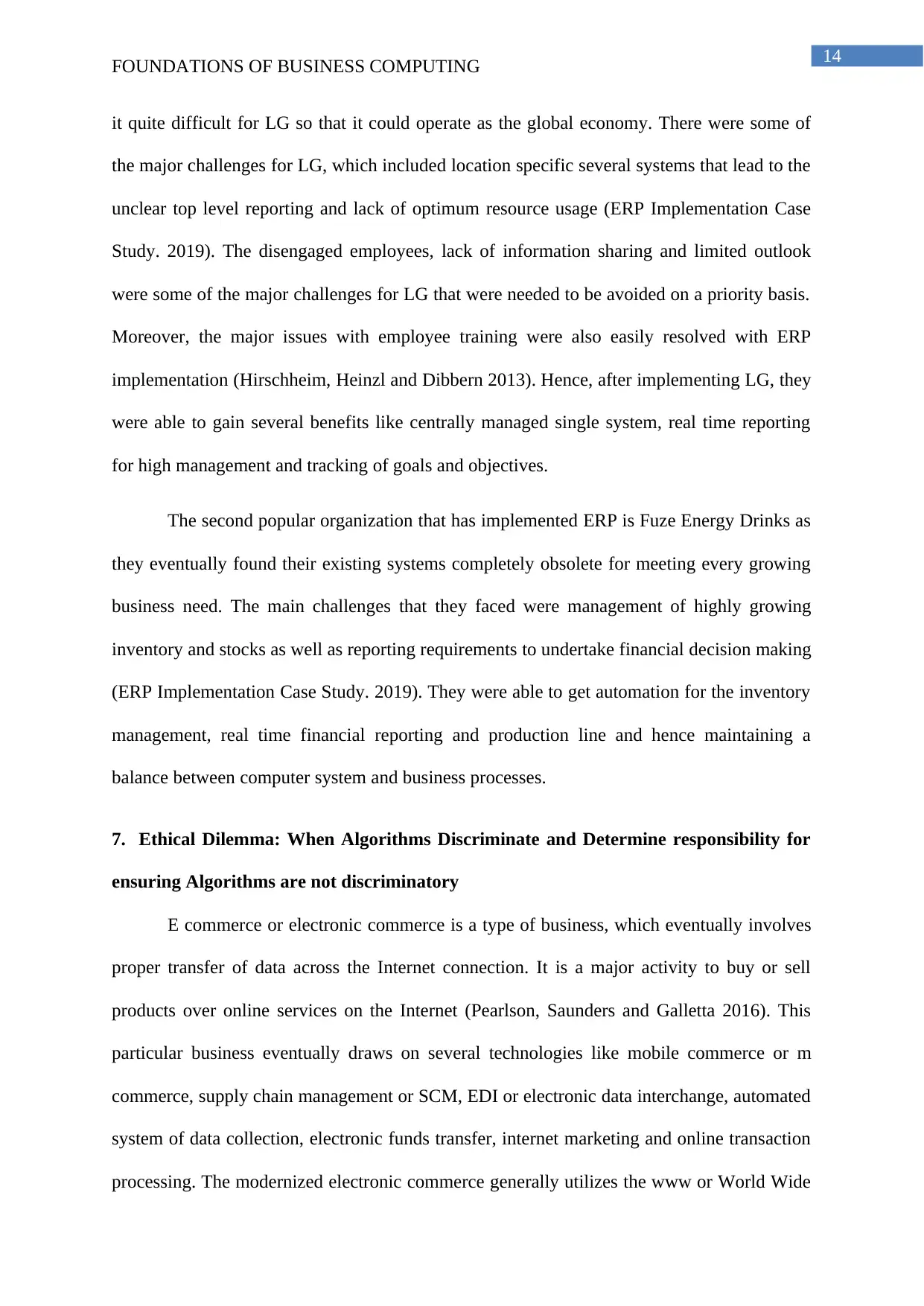
14
FOUNDATIONS OF BUSINESS COMPUTING
it quite difficult for LG so that it could operate as the global economy. There were some of
the major challenges for LG, which included location specific several systems that lead to the
unclear top level reporting and lack of optimum resource usage (ERP Implementation Case
Study. 2019). The disengaged employees, lack of information sharing and limited outlook
were some of the major challenges for LG that were needed to be avoided on a priority basis.
Moreover, the major issues with employee training were also easily resolved with ERP
implementation (Hirschheim, Heinzl and Dibbern 2013). Hence, after implementing LG, they
were able to gain several benefits like centrally managed single system, real time reporting
for high management and tracking of goals and objectives.
The second popular organization that has implemented ERP is Fuze Energy Drinks as
they eventually found their existing systems completely obsolete for meeting every growing
business need. The main challenges that they faced were management of highly growing
inventory and stocks as well as reporting requirements to undertake financial decision making
(ERP Implementation Case Study. 2019). They were able to get automation for the inventory
management, real time financial reporting and production line and hence maintaining a
balance between computer system and business processes.
7. Ethical Dilemma: When Algorithms Discriminate and Determine responsibility for
ensuring Algorithms are not discriminatory
E commerce or electronic commerce is a type of business, which eventually involves
proper transfer of data across the Internet connection. It is a major activity to buy or sell
products over online services on the Internet (Pearlson, Saunders and Galletta 2016). This
particular business eventually draws on several technologies like mobile commerce or m
commerce, supply chain management or SCM, EDI or electronic data interchange, automated
system of data collection, electronic funds transfer, internet marketing and online transaction
processing. The modernized electronic commerce generally utilizes the www or World Wide
FOUNDATIONS OF BUSINESS COMPUTING
it quite difficult for LG so that it could operate as the global economy. There were some of
the major challenges for LG, which included location specific several systems that lead to the
unclear top level reporting and lack of optimum resource usage (ERP Implementation Case
Study. 2019). The disengaged employees, lack of information sharing and limited outlook
were some of the major challenges for LG that were needed to be avoided on a priority basis.
Moreover, the major issues with employee training were also easily resolved with ERP
implementation (Hirschheim, Heinzl and Dibbern 2013). Hence, after implementing LG, they
were able to gain several benefits like centrally managed single system, real time reporting
for high management and tracking of goals and objectives.
The second popular organization that has implemented ERP is Fuze Energy Drinks as
they eventually found their existing systems completely obsolete for meeting every growing
business need. The main challenges that they faced were management of highly growing
inventory and stocks as well as reporting requirements to undertake financial decision making
(ERP Implementation Case Study. 2019). They were able to get automation for the inventory
management, real time financial reporting and production line and hence maintaining a
balance between computer system and business processes.
7. Ethical Dilemma: When Algorithms Discriminate and Determine responsibility for
ensuring Algorithms are not discriminatory
E commerce or electronic commerce is a type of business, which eventually involves
proper transfer of data across the Internet connection. It is a major activity to buy or sell
products over online services on the Internet (Pearlson, Saunders and Galletta 2016). This
particular business eventually draws on several technologies like mobile commerce or m
commerce, supply chain management or SCM, EDI or electronic data interchange, automated
system of data collection, electronic funds transfer, internet marketing and online transaction
processing. The modernized electronic commerce generally utilizes the www or World Wide
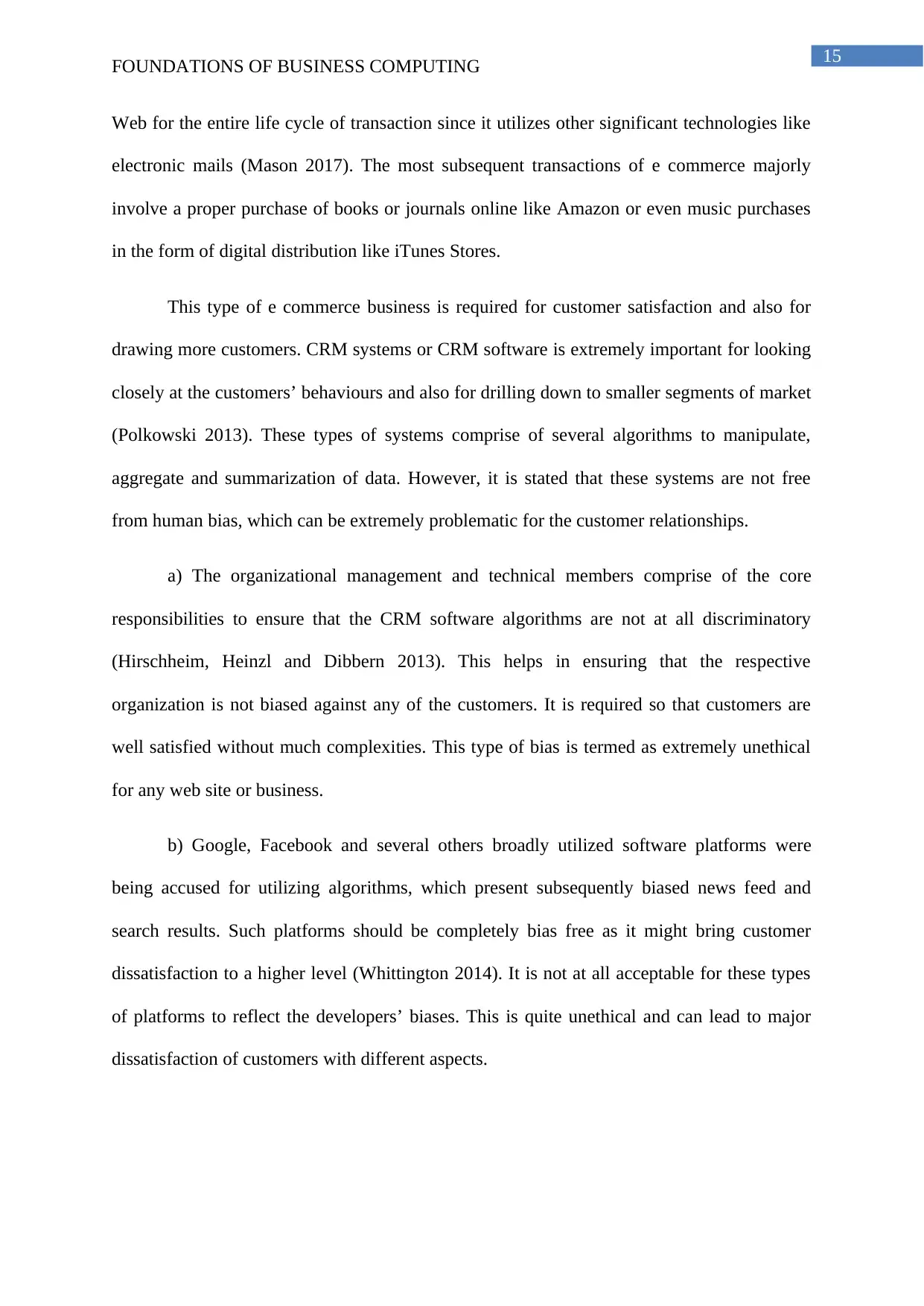
15
FOUNDATIONS OF BUSINESS COMPUTING
Web for the entire life cycle of transaction since it utilizes other significant technologies like
electronic mails (Mason 2017). The most subsequent transactions of e commerce majorly
involve a proper purchase of books or journals online like Amazon or even music purchases
in the form of digital distribution like iTunes Stores.
This type of e commerce business is required for customer satisfaction and also for
drawing more customers. CRM systems or CRM software is extremely important for looking
closely at the customers’ behaviours and also for drilling down to smaller segments of market
(Polkowski 2013). These types of systems comprise of several algorithms to manipulate,
aggregate and summarization of data. However, it is stated that these systems are not free
from human bias, which can be extremely problematic for the customer relationships.
a) The organizational management and technical members comprise of the core
responsibilities to ensure that the CRM software algorithms are not at all discriminatory
(Hirschheim, Heinzl and Dibbern 2013). This helps in ensuring that the respective
organization is not biased against any of the customers. It is required so that customers are
well satisfied without much complexities. This type of bias is termed as extremely unethical
for any web site or business.
b) Google, Facebook and several others broadly utilized software platforms were
being accused for utilizing algorithms, which present subsequently biased news feed and
search results. Such platforms should be completely bias free as it might bring customer
dissatisfaction to a higher level (Whittington 2014). It is not at all acceptable for these types
of platforms to reflect the developers’ biases. This is quite unethical and can lead to major
dissatisfaction of customers with different aspects.
FOUNDATIONS OF BUSINESS COMPUTING
Web for the entire life cycle of transaction since it utilizes other significant technologies like
electronic mails (Mason 2017). The most subsequent transactions of e commerce majorly
involve a proper purchase of books or journals online like Amazon or even music purchases
in the form of digital distribution like iTunes Stores.
This type of e commerce business is required for customer satisfaction and also for
drawing more customers. CRM systems or CRM software is extremely important for looking
closely at the customers’ behaviours and also for drilling down to smaller segments of market
(Polkowski 2013). These types of systems comprise of several algorithms to manipulate,
aggregate and summarization of data. However, it is stated that these systems are not free
from human bias, which can be extremely problematic for the customer relationships.
a) The organizational management and technical members comprise of the core
responsibilities to ensure that the CRM software algorithms are not at all discriminatory
(Hirschheim, Heinzl and Dibbern 2013). This helps in ensuring that the respective
organization is not biased against any of the customers. It is required so that customers are
well satisfied without much complexities. This type of bias is termed as extremely unethical
for any web site or business.
b) Google, Facebook and several others broadly utilized software platforms were
being accused for utilizing algorithms, which present subsequently biased news feed and
search results. Such platforms should be completely bias free as it might bring customer
dissatisfaction to a higher level (Whittington 2014). It is not at all acceptable for these types
of platforms to reflect the developers’ biases. This is quite unethical and can lead to major
dissatisfaction of customers with different aspects.
Secure Best Marks with AI Grader
Need help grading? Try our AI Grader for instant feedback on your assignments.
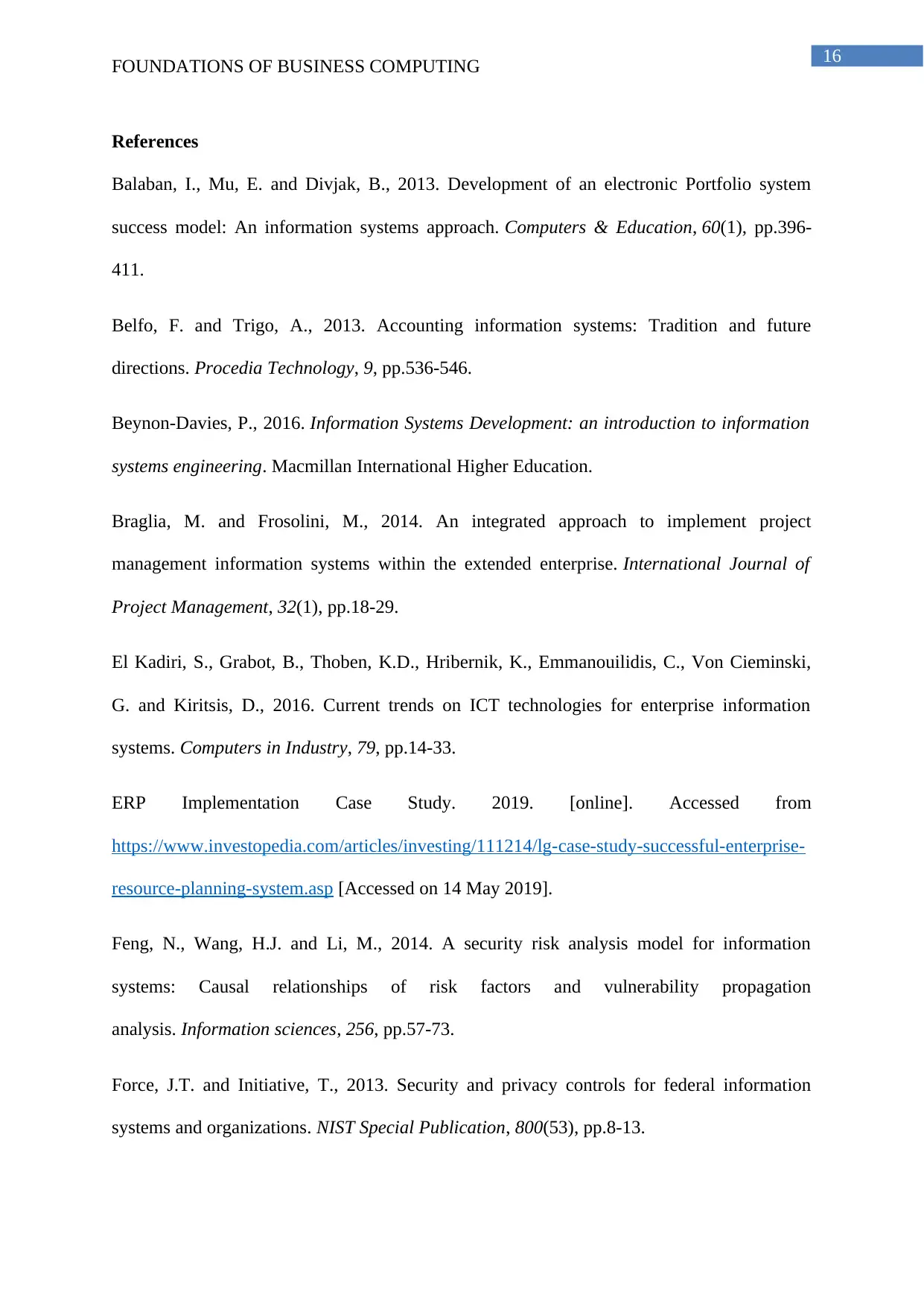
16
FOUNDATIONS OF BUSINESS COMPUTING
References
Balaban, I., Mu, E. and Divjak, B., 2013. Development of an electronic Portfolio system
success model: An information systems approach. Computers & Education, 60(1), pp.396-
411.
Belfo, F. and Trigo, A., 2013. Accounting information systems: Tradition and future
directions. Procedia Technology, 9, pp.536-546.
Beynon-Davies, P., 2016. Information Systems Development: an introduction to information
systems engineering. Macmillan International Higher Education.
Braglia, M. and Frosolini, M., 2014. An integrated approach to implement project
management information systems within the extended enterprise. International Journal of
Project Management, 32(1), pp.18-29.
El Kadiri, S., Grabot, B., Thoben, K.D., Hribernik, K., Emmanouilidis, C., Von Cieminski,
G. and Kiritsis, D., 2016. Current trends on ICT technologies for enterprise information
systems. Computers in Industry, 79, pp.14-33.
ERP Implementation Case Study. 2019. [online]. Accessed from
https://www.investopedia.com/articles/investing/111214/lg-case-study-successful-enterprise-
resource-planning-system.asp [Accessed on 14 May 2019].
Feng, N., Wang, H.J. and Li, M., 2014. A security risk analysis model for information
systems: Causal relationships of risk factors and vulnerability propagation
analysis. Information sciences, 256, pp.57-73.
Force, J.T. and Initiative, T., 2013. Security and privacy controls for federal information
systems and organizations. NIST Special Publication, 800(53), pp.8-13.
FOUNDATIONS OF BUSINESS COMPUTING
References
Balaban, I., Mu, E. and Divjak, B., 2013. Development of an electronic Portfolio system
success model: An information systems approach. Computers & Education, 60(1), pp.396-
411.
Belfo, F. and Trigo, A., 2013. Accounting information systems: Tradition and future
directions. Procedia Technology, 9, pp.536-546.
Beynon-Davies, P., 2016. Information Systems Development: an introduction to information
systems engineering. Macmillan International Higher Education.
Braglia, M. and Frosolini, M., 2014. An integrated approach to implement project
management information systems within the extended enterprise. International Journal of
Project Management, 32(1), pp.18-29.
El Kadiri, S., Grabot, B., Thoben, K.D., Hribernik, K., Emmanouilidis, C., Von Cieminski,
G. and Kiritsis, D., 2016. Current trends on ICT technologies for enterprise information
systems. Computers in Industry, 79, pp.14-33.
ERP Implementation Case Study. 2019. [online]. Accessed from
https://www.investopedia.com/articles/investing/111214/lg-case-study-successful-enterprise-
resource-planning-system.asp [Accessed on 14 May 2019].
Feng, N., Wang, H.J. and Li, M., 2014. A security risk analysis model for information
systems: Causal relationships of risk factors and vulnerability propagation
analysis. Information sciences, 256, pp.57-73.
Force, J.T. and Initiative, T., 2013. Security and privacy controls for federal information
systems and organizations. NIST Special Publication, 800(53), pp.8-13.
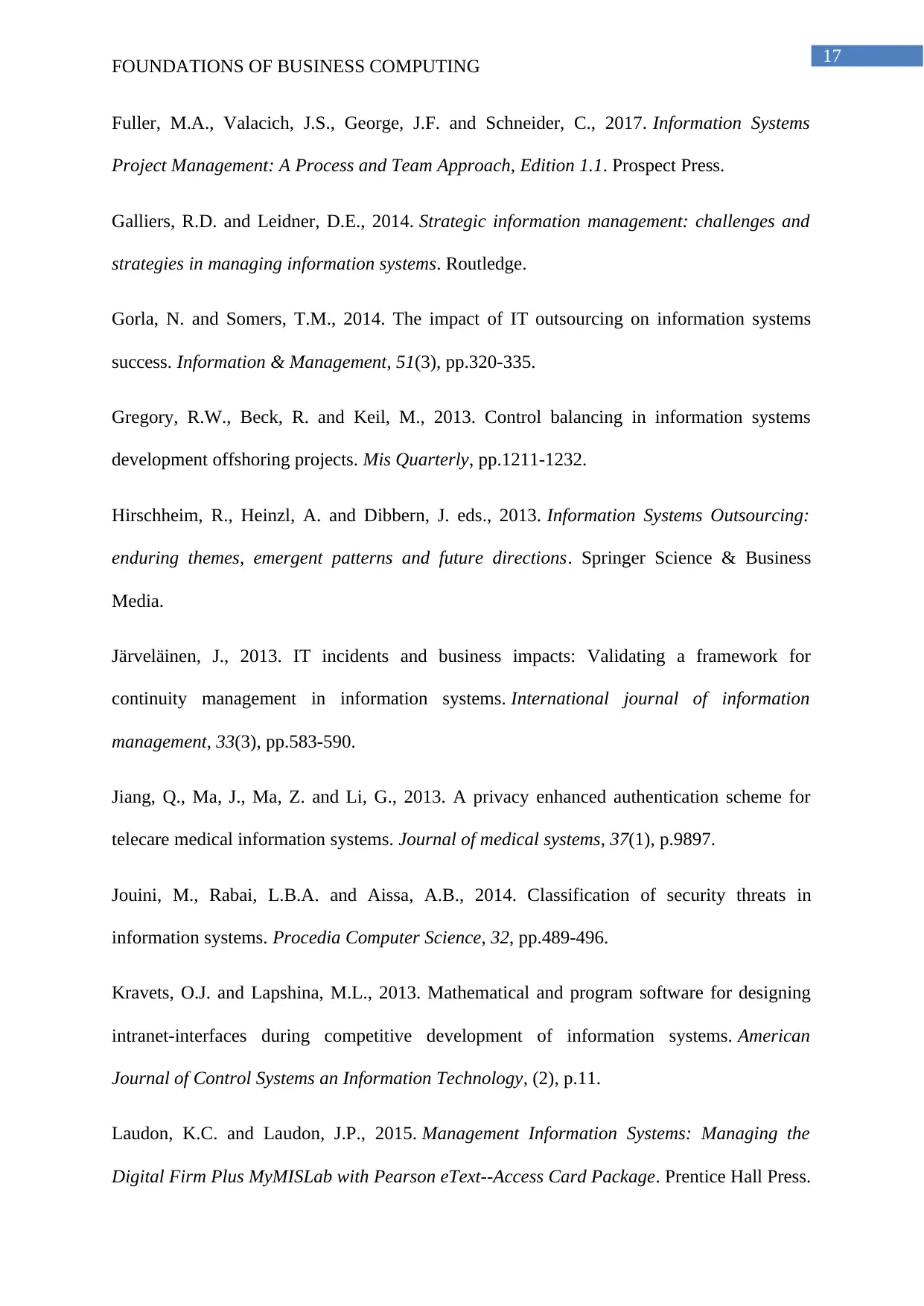
17
FOUNDATIONS OF BUSINESS COMPUTING
Fuller, M.A., Valacich, J.S., George, J.F. and Schneider, C., 2017. Information Systems
Project Management: A Process and Team Approach, Edition 1.1. Prospect Press.
Galliers, R.D. and Leidner, D.E., 2014. Strategic information management: challenges and
strategies in managing information systems. Routledge.
Gorla, N. and Somers, T.M., 2014. The impact of IT outsourcing on information systems
success. Information & Management, 51(3), pp.320-335.
Gregory, R.W., Beck, R. and Keil, M., 2013. Control balancing in information systems
development offshoring projects. Mis Quarterly, pp.1211-1232.
Hirschheim, R., Heinzl, A. and Dibbern, J. eds., 2013. Information Systems Outsourcing:
enduring themes, emergent patterns and future directions. Springer Science & Business
Media.
Järveläinen, J., 2013. IT incidents and business impacts: Validating a framework for
continuity management in information systems. International journal of information
management, 33(3), pp.583-590.
Jiang, Q., Ma, J., Ma, Z. and Li, G., 2013. A privacy enhanced authentication scheme for
telecare medical information systems. Journal of medical systems, 37(1), p.9897.
Jouini, M., Rabai, L.B.A. and Aissa, A.B., 2014. Classification of security threats in
information systems. Procedia Computer Science, 32, pp.489-496.
Kravets, O.J. and Lapshina, M.L., 2013. Mathematical and program software for designing
intranet-interfaces during competitive development of information systems. American
Journal of Control Systems an Information Technology, (2), p.11.
Laudon, K.C. and Laudon, J.P., 2015. Management Information Systems: Managing the
Digital Firm Plus MyMISLab with Pearson eText--Access Card Package. Prentice Hall Press.
FOUNDATIONS OF BUSINESS COMPUTING
Fuller, M.A., Valacich, J.S., George, J.F. and Schneider, C., 2017. Information Systems
Project Management: A Process and Team Approach, Edition 1.1. Prospect Press.
Galliers, R.D. and Leidner, D.E., 2014. Strategic information management: challenges and
strategies in managing information systems. Routledge.
Gorla, N. and Somers, T.M., 2014. The impact of IT outsourcing on information systems
success. Information & Management, 51(3), pp.320-335.
Gregory, R.W., Beck, R. and Keil, M., 2013. Control balancing in information systems
development offshoring projects. Mis Quarterly, pp.1211-1232.
Hirschheim, R., Heinzl, A. and Dibbern, J. eds., 2013. Information Systems Outsourcing:
enduring themes, emergent patterns and future directions. Springer Science & Business
Media.
Järveläinen, J., 2013. IT incidents and business impacts: Validating a framework for
continuity management in information systems. International journal of information
management, 33(3), pp.583-590.
Jiang, Q., Ma, J., Ma, Z. and Li, G., 2013. A privacy enhanced authentication scheme for
telecare medical information systems. Journal of medical systems, 37(1), p.9897.
Jouini, M., Rabai, L.B.A. and Aissa, A.B., 2014. Classification of security threats in
information systems. Procedia Computer Science, 32, pp.489-496.
Kravets, O.J. and Lapshina, M.L., 2013. Mathematical and program software for designing
intranet-interfaces during competitive development of information systems. American
Journal of Control Systems an Information Technology, (2), p.11.
Laudon, K.C. and Laudon, J.P., 2015. Management Information Systems: Managing the
Digital Firm Plus MyMISLab with Pearson eText--Access Card Package. Prentice Hall Press.
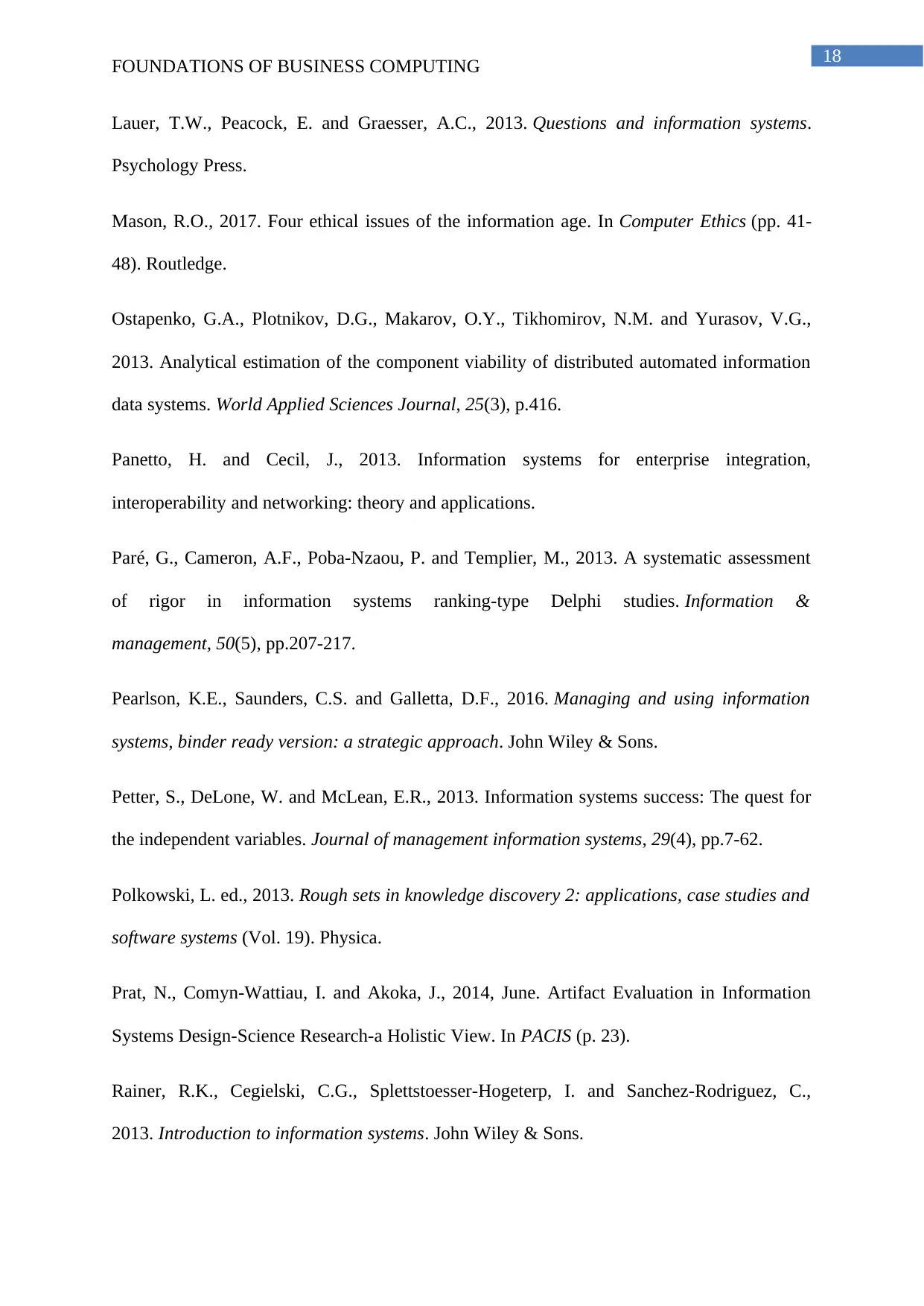
18
FOUNDATIONS OF BUSINESS COMPUTING
Lauer, T.W., Peacock, E. and Graesser, A.C., 2013. Questions and information systems.
Psychology Press.
Mason, R.O., 2017. Four ethical issues of the information age. In Computer Ethics (pp. 41-
48). Routledge.
Ostapenko, G.A., Plotnikov, D.G., Makarov, O.Y., Tikhomirov, N.M. and Yurasov, V.G.,
2013. Analytical estimation of the component viability of distributed automated information
data systems. World Applied Sciences Journal, 25(3), p.416.
Panetto, H. and Cecil, J., 2013. Information systems for enterprise integration,
interoperability and networking: theory and applications.
Paré, G., Cameron, A.F., Poba-Nzaou, P. and Templier, M., 2013. A systematic assessment
of rigor in information systems ranking-type Delphi studies. Information &
management, 50(5), pp.207-217.
Pearlson, K.E., Saunders, C.S. and Galletta, D.F., 2016. Managing and using information
systems, binder ready version: a strategic approach. John Wiley & Sons.
Petter, S., DeLone, W. and McLean, E.R., 2013. Information systems success: The quest for
the independent variables. Journal of management information systems, 29(4), pp.7-62.
Polkowski, L. ed., 2013. Rough sets in knowledge discovery 2: applications, case studies and
software systems (Vol. 19). Physica.
Prat, N., Comyn-Wattiau, I. and Akoka, J., 2014, June. Artifact Evaluation in Information
Systems Design-Science Research-a Holistic View. In PACIS (p. 23).
Rainer, R.K., Cegielski, C.G., Splettstoesser-Hogeterp, I. and Sanchez-Rodriguez, C.,
2013. Introduction to information systems. John Wiley & Sons.
FOUNDATIONS OF BUSINESS COMPUTING
Lauer, T.W., Peacock, E. and Graesser, A.C., 2013. Questions and information systems.
Psychology Press.
Mason, R.O., 2017. Four ethical issues of the information age. In Computer Ethics (pp. 41-
48). Routledge.
Ostapenko, G.A., Plotnikov, D.G., Makarov, O.Y., Tikhomirov, N.M. and Yurasov, V.G.,
2013. Analytical estimation of the component viability of distributed automated information
data systems. World Applied Sciences Journal, 25(3), p.416.
Panetto, H. and Cecil, J., 2013. Information systems for enterprise integration,
interoperability and networking: theory and applications.
Paré, G., Cameron, A.F., Poba-Nzaou, P. and Templier, M., 2013. A systematic assessment
of rigor in information systems ranking-type Delphi studies. Information &
management, 50(5), pp.207-217.
Pearlson, K.E., Saunders, C.S. and Galletta, D.F., 2016. Managing and using information
systems, binder ready version: a strategic approach. John Wiley & Sons.
Petter, S., DeLone, W. and McLean, E.R., 2013. Information systems success: The quest for
the independent variables. Journal of management information systems, 29(4), pp.7-62.
Polkowski, L. ed., 2013. Rough sets in knowledge discovery 2: applications, case studies and
software systems (Vol. 19). Physica.
Prat, N., Comyn-Wattiau, I. and Akoka, J., 2014, June. Artifact Evaluation in Information
Systems Design-Science Research-a Holistic View. In PACIS (p. 23).
Rainer, R.K., Cegielski, C.G., Splettstoesser-Hogeterp, I. and Sanchez-Rodriguez, C.,
2013. Introduction to information systems. John Wiley & Sons.
Paraphrase This Document
Need a fresh take? Get an instant paraphrase of this document with our AI Paraphraser
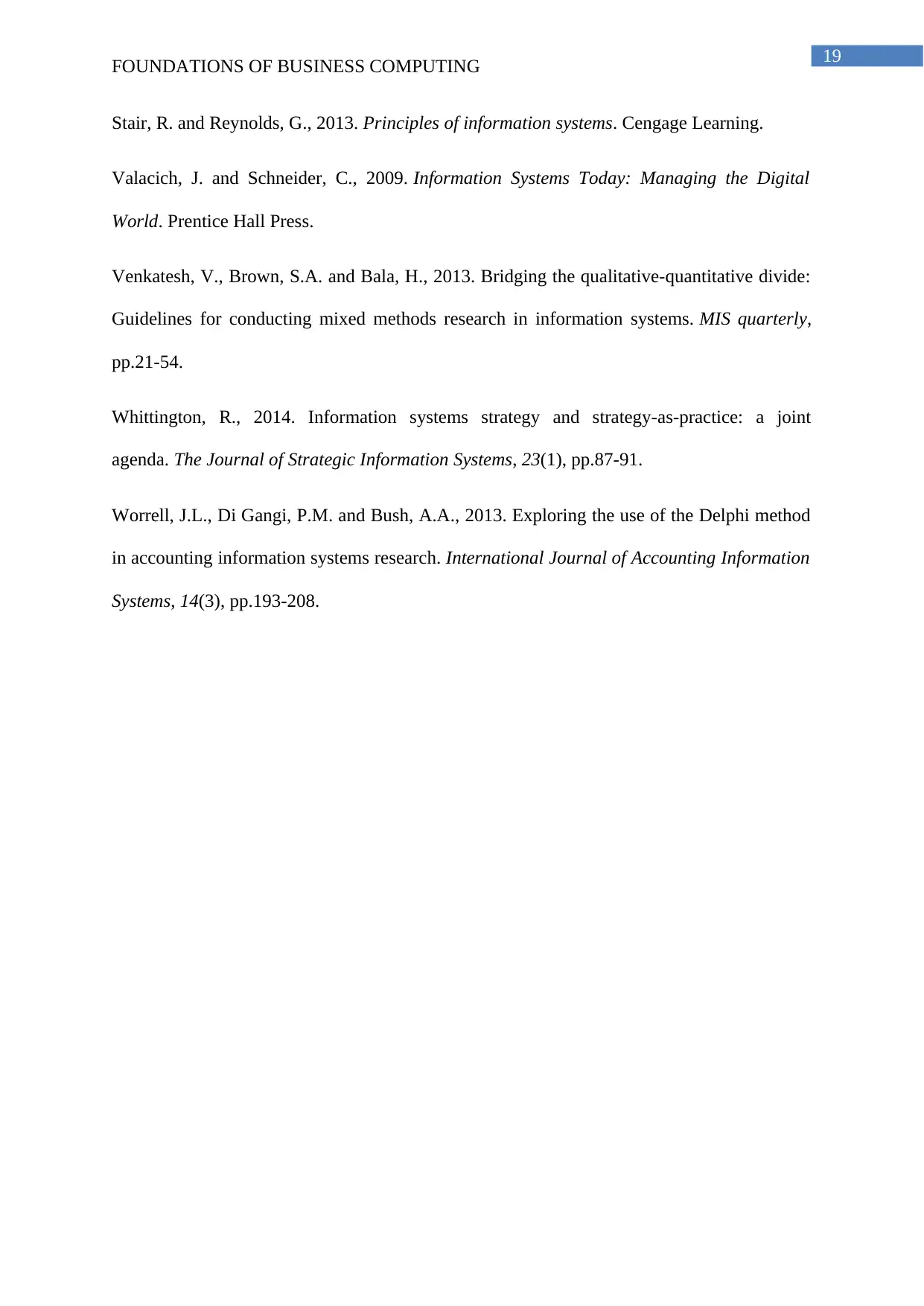
19
FOUNDATIONS OF BUSINESS COMPUTING
Stair, R. and Reynolds, G., 2013. Principles of information systems. Cengage Learning.
Valacich, J. and Schneider, C., 2009. Information Systems Today: Managing the Digital
World. Prentice Hall Press.
Venkatesh, V., Brown, S.A. and Bala, H., 2013. Bridging the qualitative-quantitative divide:
Guidelines for conducting mixed methods research in information systems. MIS quarterly,
pp.21-54.
Whittington, R., 2014. Information systems strategy and strategy-as-practice: a joint
agenda. The Journal of Strategic Information Systems, 23(1), pp.87-91.
Worrell, J.L., Di Gangi, P.M. and Bush, A.A., 2013. Exploring the use of the Delphi method
in accounting information systems research. International Journal of Accounting Information
Systems, 14(3), pp.193-208.
FOUNDATIONS OF BUSINESS COMPUTING
Stair, R. and Reynolds, G., 2013. Principles of information systems. Cengage Learning.
Valacich, J. and Schneider, C., 2009. Information Systems Today: Managing the Digital
World. Prentice Hall Press.
Venkatesh, V., Brown, S.A. and Bala, H., 2013. Bridging the qualitative-quantitative divide:
Guidelines for conducting mixed methods research in information systems. MIS quarterly,
pp.21-54.
Whittington, R., 2014. Information systems strategy and strategy-as-practice: a joint
agenda. The Journal of Strategic Information Systems, 23(1), pp.87-91.
Worrell, J.L., Di Gangi, P.M. and Bush, A.A., 2013. Exploring the use of the Delphi method
in accounting information systems research. International Journal of Accounting Information
Systems, 14(3), pp.193-208.
1 out of 20
Related Documents
Your All-in-One AI-Powered Toolkit for Academic Success.
+13062052269
info@desklib.com
Available 24*7 on WhatsApp / Email
![[object Object]](/_next/static/media/star-bottom.7253800d.svg)
Unlock your academic potential
© 2024 | Zucol Services PVT LTD | All rights reserved.





